THE AIRPORTS
FLORIDA
MIAMI INTERNATIONAL AIRPORT
MIA

| April
1956 National Airlines had a strong connection to the Miami area, and was the second airline to start scheduled passenger service to the airport in 1936 from it's home base at St. Petersburg. National Airlines would continue to grow and expand eventually making Miami its base of operations and introducing new multi-engine equipment. By 1956, National became a formidable carrier from Miami with flights to New York, Boston, Washington D.C., and Houston in the United States, and Havana, Cuba. Awaiting taxi clearance away from the terminal for a mid-day departure is N8207H, a Douglas DC-7B, delivered new to the airline in December 1953. |

| June
1959 Pan American Airways and Miami International Airport had an synonymous existence together for over sixty years, as it was Pan American whom originally moved their base of operations from Key West to Miami in 1928. The airline developed its own airport, yet by 1933 the airport became known as the 36th Street Airport and other carriers relocated there from the old Miami Municipal Airport. Over the next two decade Pan American grew to become a legendary international carrier, and kept Miami as its base of operations. By 1959, Pan American had numerous daily flights connecting Miami with New York, as well as no less then seven destinations in the Caribbean and Central America. parked at the terminal and awaiting its next load of passengers is N8519C "Clipper Liberty Bell," a Douglas DC-6B. |

|
September 1966 As its name suggested, Northeast Airlines was based in Boston, Massachusetts and started operations under that name in 1940, with flights along the Eastern Seaboard. Northeast received permission to start services to Florida including Miami in 1957 with flights to Boston, via New York. This initial route, eventually expanded and gave Northeast a lucrative piece of the popular Northeastern region to Florida market. Pure "jet" service was started in 1959 using a leased Boeing 707, and this was replaced by the airlines delivery of the sleek Convair CV-880 airplane in 1960. Seen being pushed back from the terminal for a northbound departure is N8495H, a Convair CV-880-22-1, delivered to the airline in December 1962. |
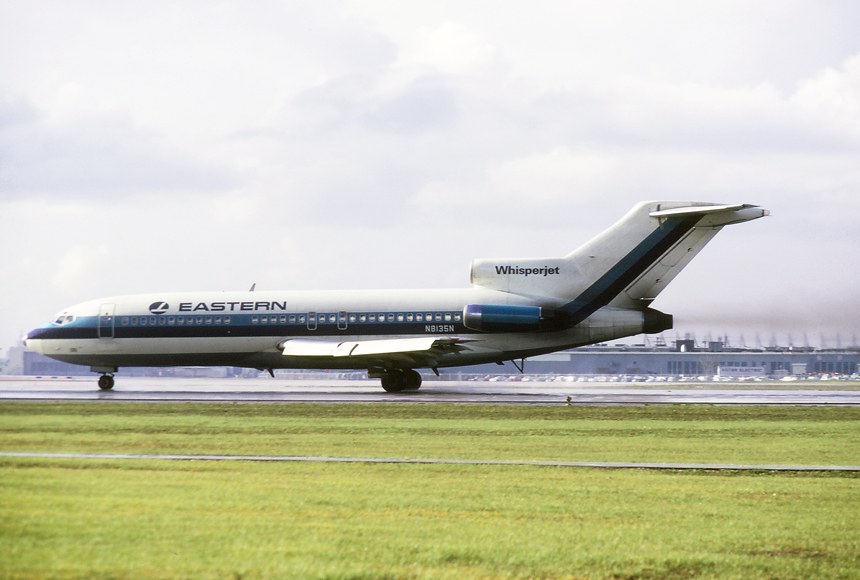
| March
1967 Another airline that would eventually grow with the Miami airport, was Atlanta, Georgia based Eastern Airlines which started service to the airport in 1934, with flights to both New York and Atlanta. Eastern took the opportunity to expand at Miami, adding services to the Midwest and Puerto Rico by the 1960s. Jet service was introduced by the airline in 1960, which greatly expended the speed and comfort for Miami bound passengers. Seen taxiing back toward the terminal after having landed on Runway 27 Right during a soggy spring afternoon is N8135N, a Boeing 727-25, delivered new to the airline in September 1965. |
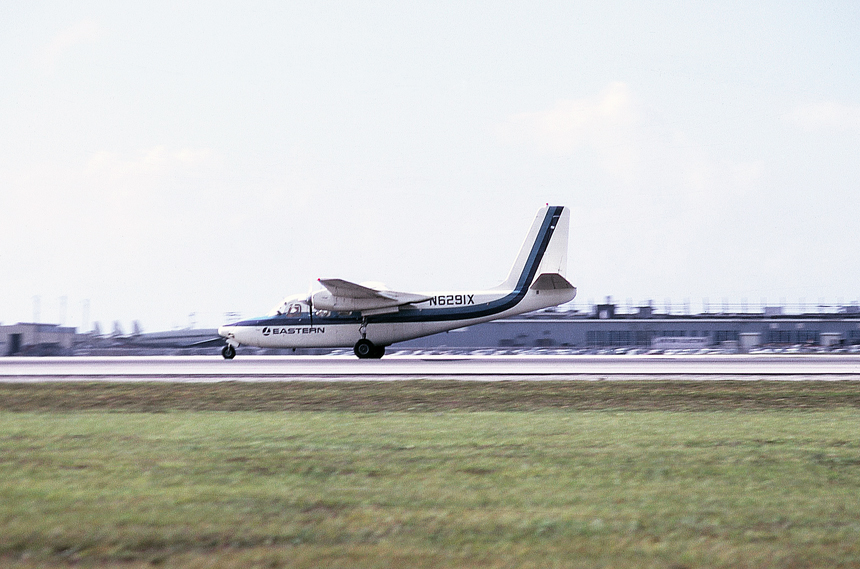
| March
1967 One A rather unique aircraft especially for a major airline was the Aero Commander turboprop operated by Eastern Airlines. Eastern acquired both an Aero Commander an Lockheed Jetstar to provide pilot training and executive transport. Based in Miami the Aero Commander was painted in full Eastern colors and operated from 1967 through 1971. Seen on its takeoff roll on Runway 27 Right is N6291X, an Aero Commander 500B. |
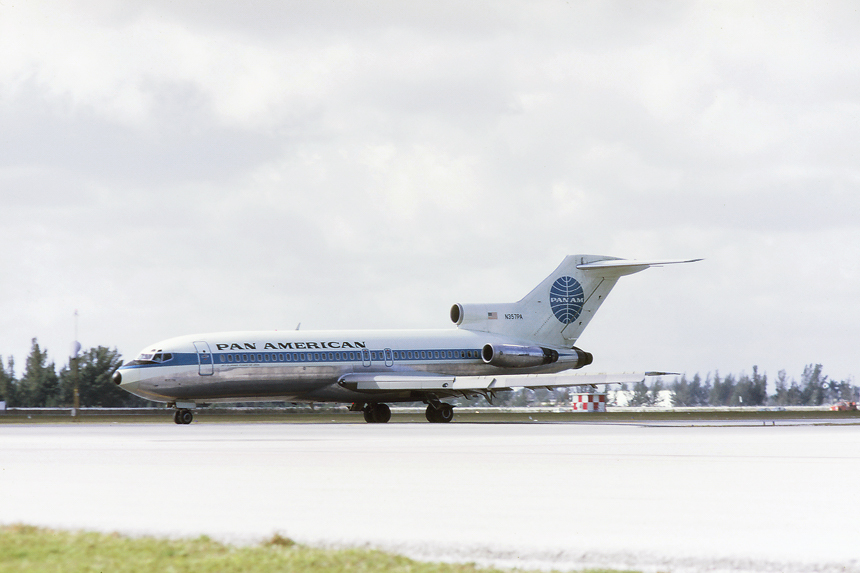
| February
1968 Pan American started the Jet-Age of commercial aviation on October 26, 1958, when the carrier inaugurated trans-Atlantic service from New York to Paris using a Boeing 707. Although Pan American was well known for its far reaching international service using the Boeing 707 and 747, the airline sought a smaller airframe for its Caribbean and Latin America routes from Miami. The answer was the Boeing 727 for which the airline received its first in 1966, and placed it on services from Miami to Mexico City, Panama City, San Juan, and San Salvador. Taxiing outbound toward Runway 27 Left for a morning departure is N357PA "Jet Clipper Ponce de Leon," a Boeing 727-21, delivered new to the airline a year earlier in May 1967 |
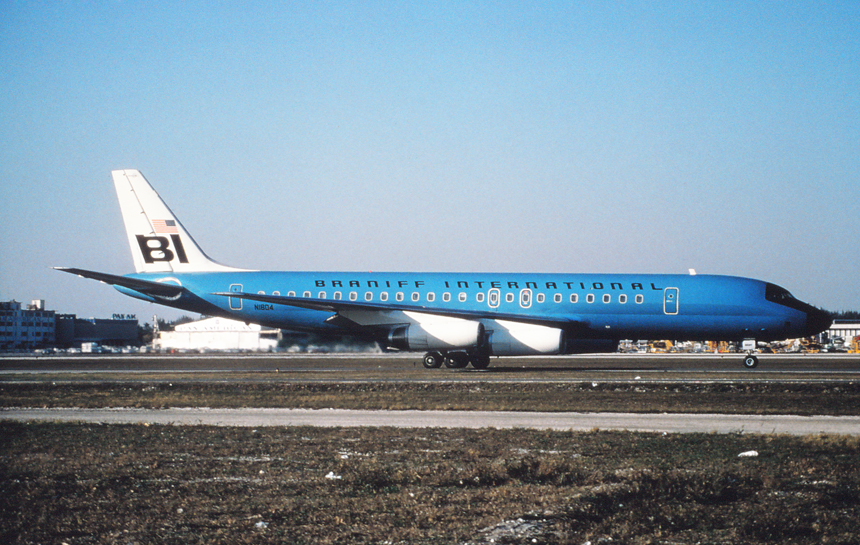
|
September 1968 Braniff International Airways received approval from the Civil Aeronautics Board (CAB) to start service into Miami in 1952, to Houston, Havana, and Panama City (Balboa) using a Douglas DC-6. After the purchase of Pan American-Grace Airways (PANAGRA) in 1967, Braniff became the largest U.S. carrier to serve South America. Miami saw Braniff take over routes to Bogotá, Guayaquil, Lima, and Santiago using Douglas DC-8s and Boeing 707s on the intercontinental services. Seen taxiing to the terminal after having landed is N1804, a Douglas DC-8-62, wearing the "Medium Blue" colors. |
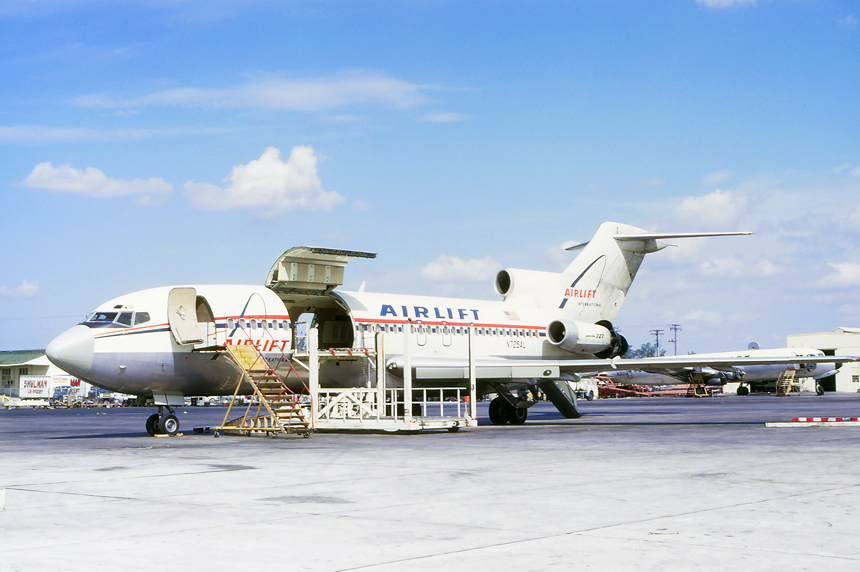
| March
1969 Miami based Riddle Airlines changed its name to Airlift International in 1965. The all cargo airline continued to expand operations and purchased Slick Airways in 1968. Boeing 727 Freighters were added to supplement the Douglas DC-8, Boeing 707 and various second-hand prop-liners on cargo services to San Juan, Puerto Rico, New York, Chicago, and Detroit. Seen parked on the Airlift cargo ramp and awaiting its next load of freight is N725AL, a Boeing 727-172C, delivered new to Airlift in May 1968. |
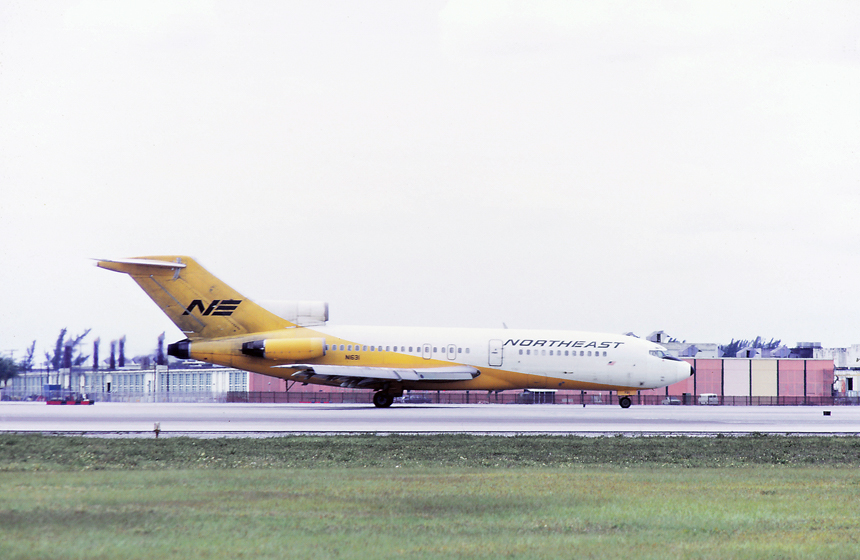
| March
1969 By the 1960s, Northeast Airlines had become one of the more popular carriers flying between Florida and the Northeast. With a change in ownership in 1965, the airline introduced a new color scheme and corporate rebranding that would paint the planes in a sun drenched yellow. What became affectionately known as the "Yellowbirds," the rather plain, white and yellow colors giving southbound Florida passengers a hint of the "warmth" they would soon be experiencing. Seen taxiing out to Runway 9 Left for an afternoon departure is N1631, a Boeing 727-95, delivered new to the airline in October 1965. |
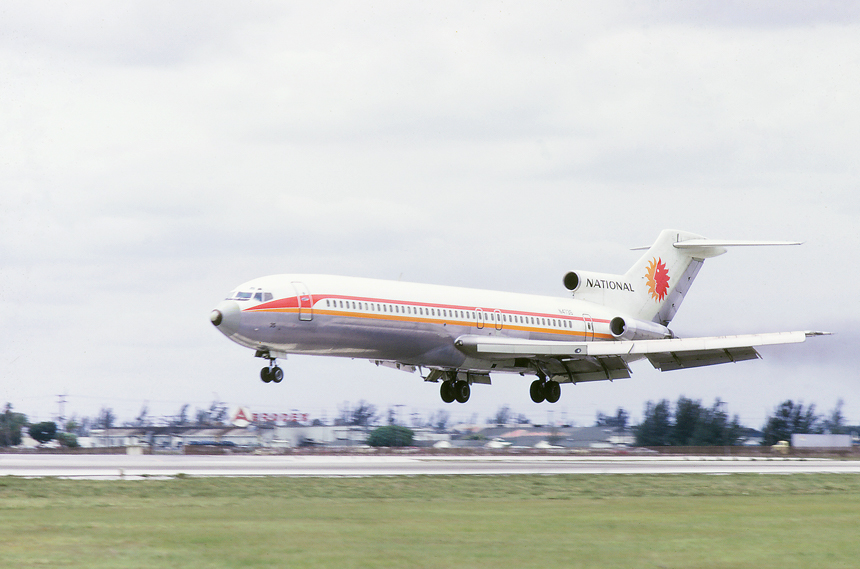
| March 1969 National Airlines became the first U.S. domestic to start jet service when it operated a leased Pan American Boeing 707 on service between Miami and New York on December 10, 1958. National Airlines would eventually acquire Douglas DC-8s and Boeing 727s to make up its jet fleet, with the first Boeing 727 delivered in 1964. The Boeing 727s were to be used on short-to-medium haul regional routes with the aircraft being used on flights from Miami to Key West, Jacksonville, West Palm Beach, Fort Meyers, and Tampa. Seen just over-the-numbers for landing on Runway 9 Left is N4735, a Boeing 727-235, delivered new to the airline in January 1968. |
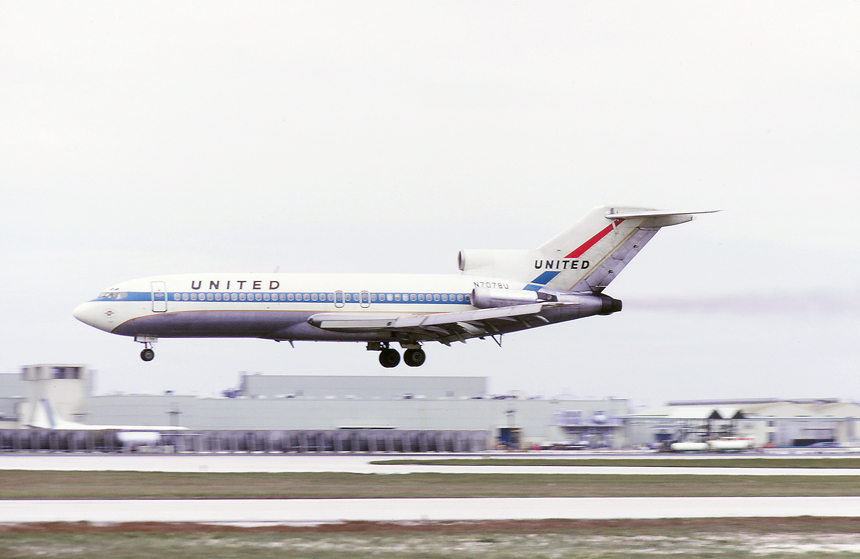
| March
1969 United Air Lines had traditionally been awarded routes across the U.S. from the Central and Northeast regions to the West. The airline had sought unsuccessfully to extend its reach toward Florida and Southeast. The solution came in the form of a purchase, of Capital Airlines in June 1961. With the acquisition of Capital, United assumed operation of the airlines routes from Cleveland, Pittsburgh, and Buffalo to Miami, as well as routes into Atlanta, thereby placing United into a much desired market. Seen over-the-numbers for landing on Runway 9 Left is N7078U, a Boeing 727-22. |
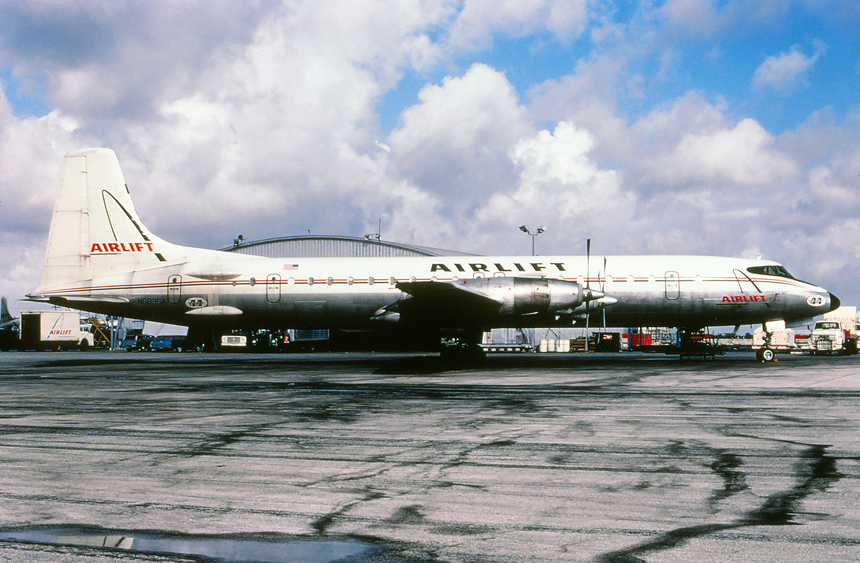
| April
1970 Canadian aircraft company Canadair received licensing rights to build the British Bristol Britannia airliner in the late 1950s and produced a unique cargo version of the aircraft. The Canadair CL-44 cargo version, which included a swing-tail which would allow loading and unloading of bulk cargo much easier. With a payload of approximately 59,000 pounds, the CL-44 was purchased by Seaboard World, Slick Airways, and The Flying Tiger Line for increased capacity. Miami based Airlift International assumed the ownership of four CL-44s when the airline purchased Slick Airways in 1968. Parked at the Airlift cargo ramp is N603SA, a Canadair CL-44D4-6, originally delivered to Slick Airways in February 1962. |
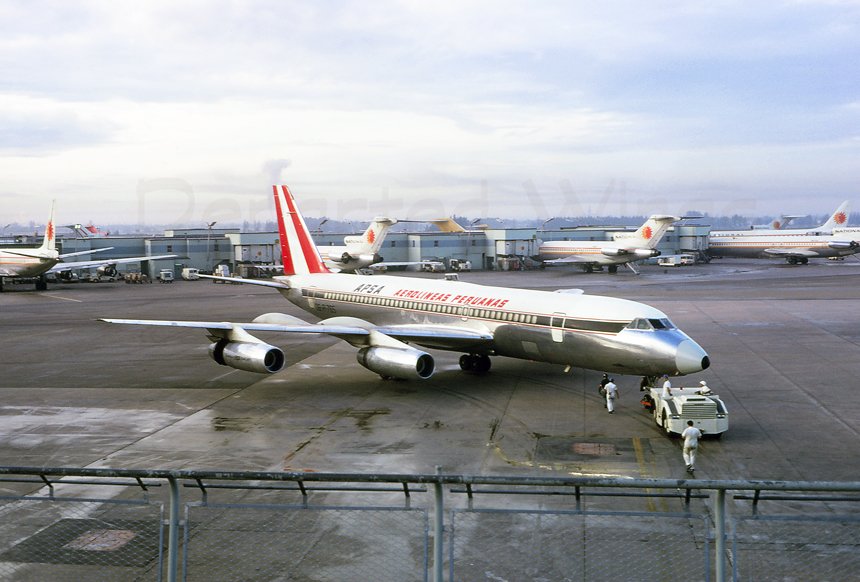
| June
1969 Aerolineas Peruanas S. A. better known as APSA was established in September 1956, becoming the national carrier of Peru. Scheduled services were started from a Lima, Peru base in 1956 with flights to both Miami and Santiago, Chile using a Douglas DC-6. APSA upgraded to jet service when it's first Convair CV-990 was put into service on the Lima-Miami route on December 1, 1963. The airline expanded international adding service to both Mexico City and Los Angeles as well as other cities in South American and Europe but ran into financial issues in 1970. Although plan for take over by the Peruvian government and Spain's Iberia airline were considered, however these did not occur and APSA went bankrupt and ceased flight operations on May 2, 1971. |

| July
1970 Braniff International Airways started a re-branding campaign in May 1965, using industrial designer Alexander Girard. Using the theme "End of the Plain Plane" Girard used a varied pallet of pastel and bold colors to change everything at the airline from stationary to aircraft. The re-branding and advertising effort was successful and helped Braniff expand into new markets and gain customers. Seen taxiing out for takeoff and wearing the "Beige" colors is N1806, a Douglas DC-8-62, delivered new to the airline on December 19, 1967. |

| October
1970 Braniff International Airways received its first pure jet aircraft when its first Boeing 707 was delivered in December 1959. Braniff was the only airline to order the 707-220 series, dubbed the "Hot and High" version with more more powerful turbojet engines. Five aircraft were ordered, however one was lost in a crash during a test flight prior to delivery. Braniff went on to acquire both the Boeing 720 and Boeing 707-100s and 320C "Intercontinental Jets" in the early 1960s, for use on their extensive routes to South America. Seen taxiing away from the gate for another international service and wearing the light "Panagra Green" colors is N107BN, a Boeing 707-138B originally with QANTAS, and purchased by Braniff in June 1969. |
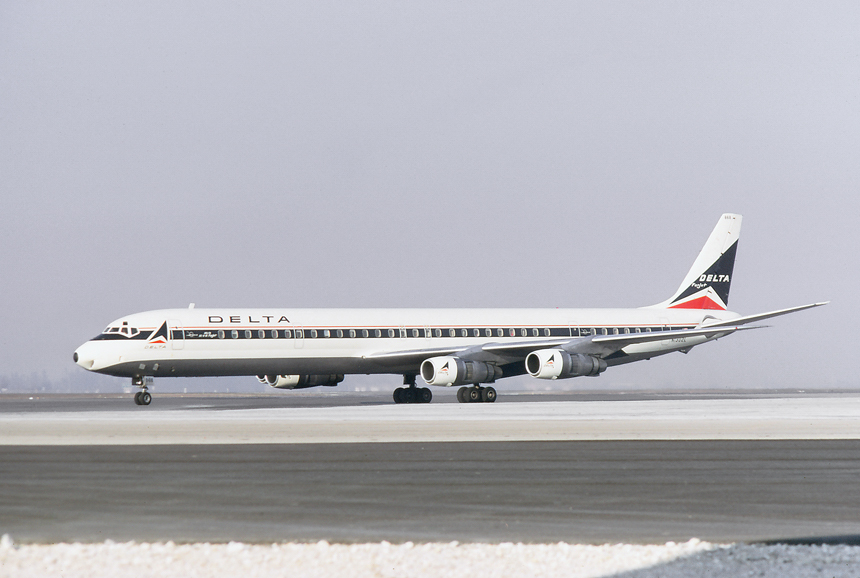
| March
1971 Delta Airlines was an early domestic operator into Miami when flights were started on December 1, 1945 on a multi-stop service to Atlanta. Within a decade Delta had added "Royal Biscayne" non-stop service from Chicago to Miami using the Douglas DC-7. Delta started "jet" service into Miami in October 1959 using the Douglas DC-8 on flights to both Chicago and Atlanta. Taxiing outbound toward Runway 27 Left for morning departure is N1302L, a Douglas DC-8-61, delivered new to the airline on January 20, 1969. |

| March
1971 The Northeast "Yellowbirds" continued to be a popular choice for travelers between the Eastern Seaboard and the sunny environs of southern Florida. By 1971, the airline was flying multiple daily flights to Miami from Boston, Hartford, New York-JFK, Philadelphia, Baltimore, and Montreal, Canada. Taxiing out toward Runway 27 Left for an afternoon departure is N1640, a Boeing 727-295, delivered new to the airline on December 18, 1967. |

| April
1971 Mackey International Airlines was a commuter created in 1969, to provide flights from southern Florida airports Miami, Fort Lauderdale, and West Palm Beach, to numerous destinations in the Bahamas and northern Caribbean Islands. Using a mixed fleet of both piston and turbine engined aircraft, including the Douglas DC-6, Mackey served now less then twenty island locations across the Bahamas, including Nassau, Marsh Harbour, Freeport, and Bimini. Parked at the terminal and awaiting its next load of passengers for an outbound flight is N442JM, a Convair CV-440-86, an ex-Eastern Airlines aircraft purchased by Mackey in December 1970 |
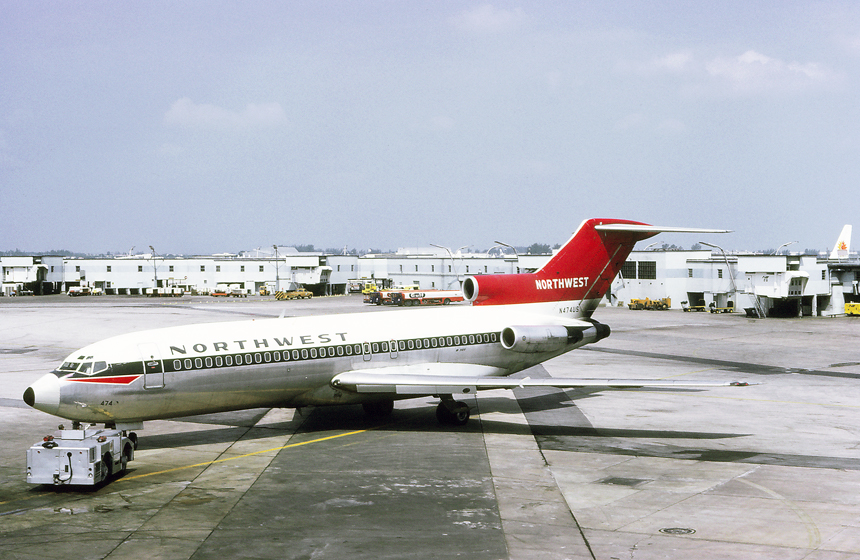
| April
1971 Northwest Airlines received permission to start service to Miami from Minneapolis via Chicago-Atlanta-Ft Lauderdale with flights being inaugurated in September 1959. The Minneapolis, Minnesota based airline as its name suggested had all its flights located along the north and northwest portions of the United States, aside from its international service. The Florida service opened a new market for the airline, especially to the winter-weary travelers in the central states looking for warmth and sun. By 1971, Northwest had non-stop flights from Miami to Chicago, Ft. Lauderdale, and Tampa. Seen being pushed back from the gate for a northbound flight is N475US, a Boeing 727-51, delivered new to the airline in May 1966. |
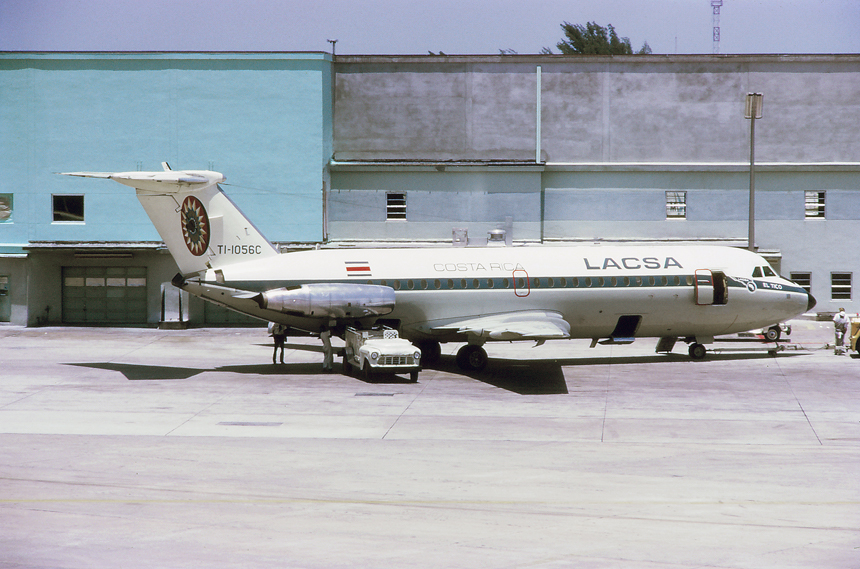
| April
1971 One of the first international airlines to start service into Miami was Lineas Aereas Costarricenses S. A. (LACSA) was originally founded by Pan American Airways in 1945. In 1949, the airline was designated the national carrier for Costa Rica and a year later in 1950, services were started from San Jose, Costa Rica to Miami via Havana, Cuba using a Curtis C-45. In 1966, LACSA purchased its first jet, a British Aerospace BAC-1-11 "Twin-Jet" allowing increased capacity and speed on its flagship route; San Jose-Grand Cayman-Miami. Parked at the terminal and being loaded for another southwest bound flight is TI-1056C "El Tico," a British Aerospace BAC-1-11-409AY. |
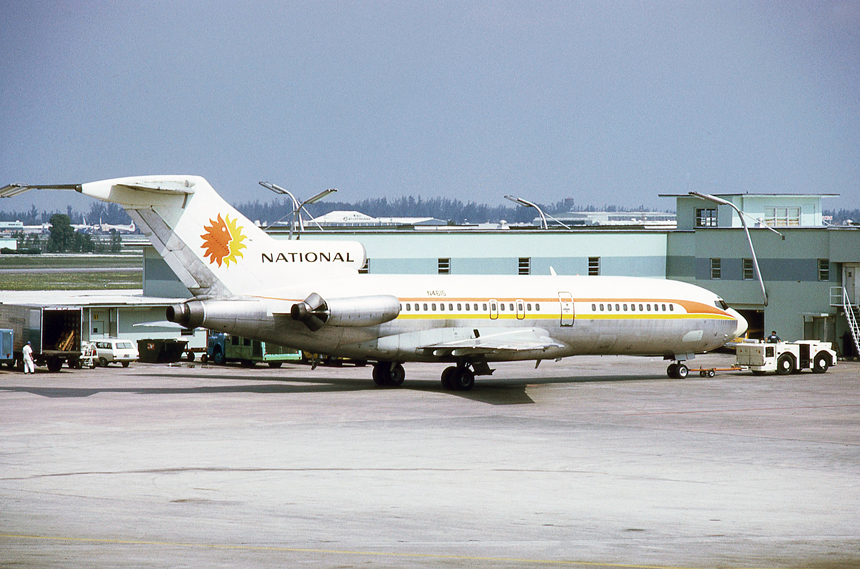
| April
1971 National Airlines added its first of ten ordered Boeing 727s to its fleet in 1964, when a series-100 was delivered. Used to help retire the piston-era aircraft of the Douglas DC-6 and DC-7, as well as an eventual replacement to the Lockheed Electra, the Boeing 727 brought speed and comfort to many of National Airlines short-and-medium range routes. Seen being pushed back from the terminal is N4615, a Boeing 727-35, delivered new to the airline in February 1965. |
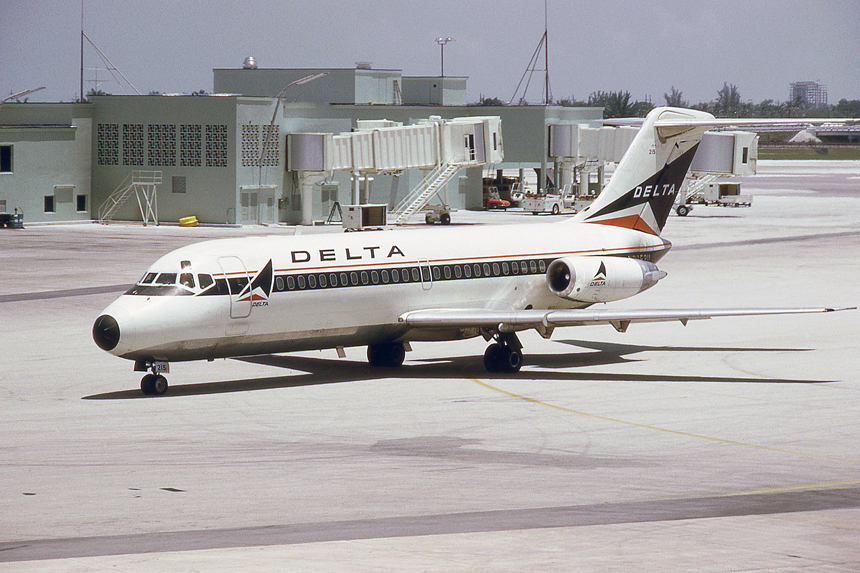
| April
1971 Delta Airlines ordered the the Douglas DC-9 to introduce "jet" service to many small or intermediate destinations throughout its route map. At the time of development in 1963, the Douglas DC-9 was designed to operate to 98% of the commercial airports in the United States at that time. Delta became the first airline in the world to inaugurate Douglas DC-9 "Fan Jet" service on November 29, 1965 on a Atlanta-Memphis-Kansas City route. During the early 1970s, Miami saw the Douglas DC-9s being used on routes to Cincinnati, Columbus, Memphis, and Tampa. Seen taxiing inbound toward the gate after a regional flight is N8953U, a Douglas DC-9-15, originally with Northeast Airlines. |
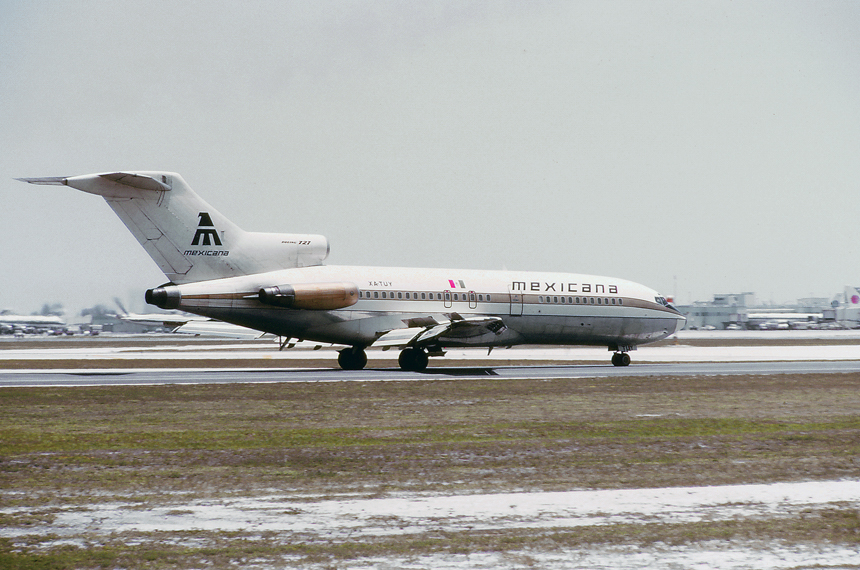
| April
1971 In 1966, Mexicana Airlines which had only served Los Angeles in the United States, was granted permission to expand its routes and added six additional cities including Miami to its route map. Early service to Miami utilized the airlines new Boeing 727s on a sole route to the island paradise of Cozumel and helped the Latin airline establish a presence in the popular Miami market. Seen rolling out on Runway 12 is XA-TUY "Mexico," a Boeing 727-114, originally delivered to Pacific Southwest Airlines (PSA) in 1967, and purchased by Mexicana in December 1968. |
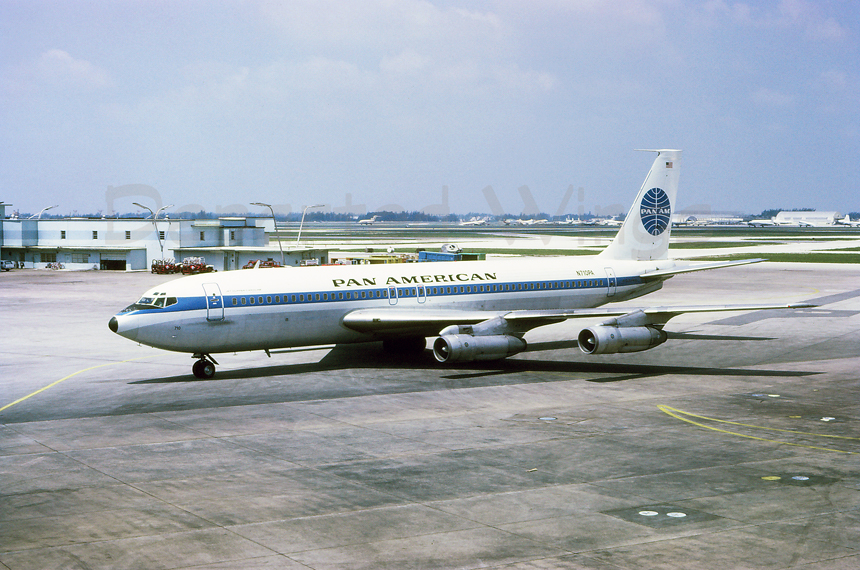
| April
1971 Pan American World Airways was the airline that made history when it introduced the "Jet Age" on October 26, 1958 when it inaugurated Boeing 707 service between New York and Paris. Pan American continued to make history as additional routes specifically trans-Atlantic flights were flown with pure jet aircraft notable the Boeing 707. Only a few years later Miami was introduced to Pan American Jet service when Boeing 707s were placed on flights to New York-Idlewild, San Juan, and Havana. Seen taxiing toward the gate at Concourse E is N710PA "Jet Clipper Caroline," a Boeing 707-121(B). This aircraft was delivered to Pan American on September 29, 1958 and subsequently leased to National Airlines which became the first U.S. airline to start jet service in the United States between new York and Miami on December 10, 1958. |
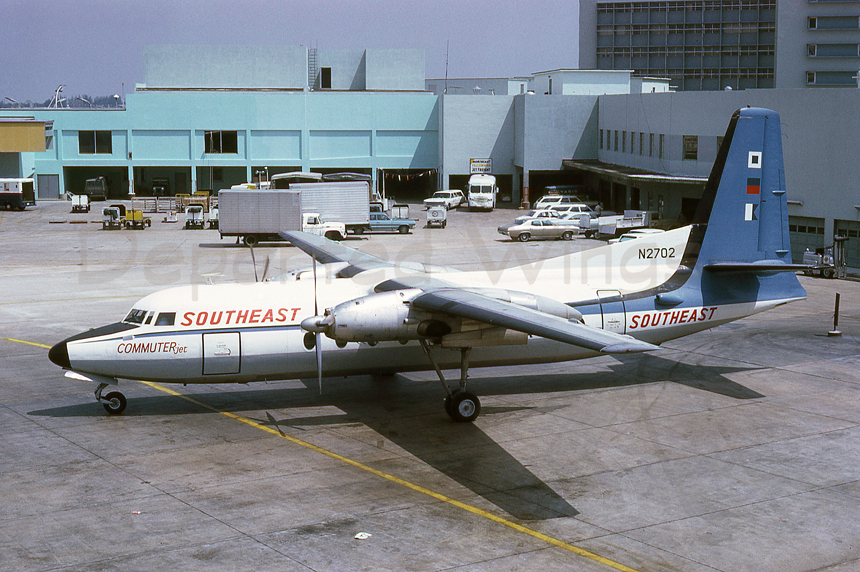
| April
1971 Southeast Airlines was established at Miami International Airport in 1965 to provide "commuter" flights to Key West, Florida. Fairchild F-27 "Commuter Jets" were introduced in 1966 with the airline advertising "35-minute service to Key West." By 1971, flights were started between Marathon and Miami in additional to it's popular five daily services to Key West. Seen starting its engines for an afternoon flight to Key West is N2702, a Fairchild F-27, purchased by Southeast in May 1970. |
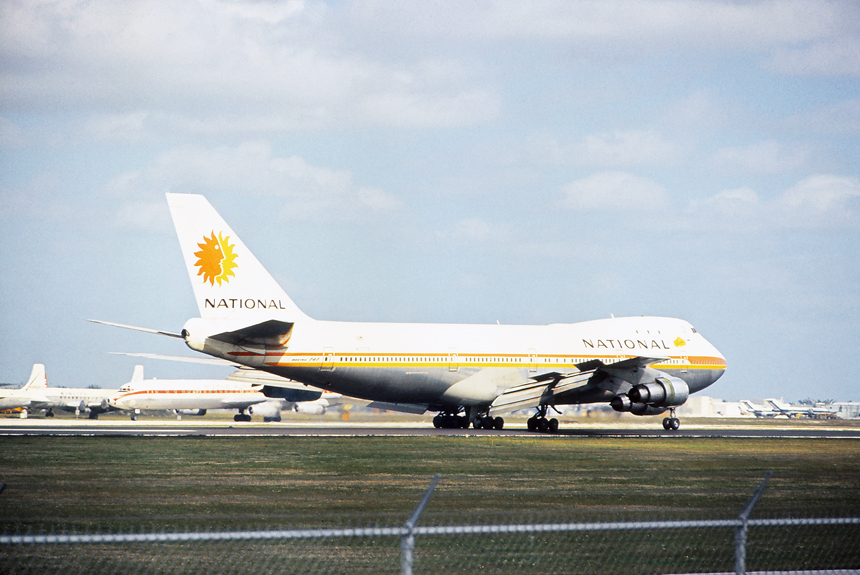
| October
1971 National Airlines followed suit with many of the major airlines placing orders for the new "Queen of the Skies" Boeing 747 which at the time of delivery was the largest commercial airliner. National's first of two ordered Boeing 747s was placed into service on October 1, 1970 between Miami and New York-JFK, and a few weeks later between Miami and Los Angeles. Eventually the Boeing 747 was used to inaugurate National's first European service from Miami to London in 1973, replacing the Douglas DC-8s being used on the trans-Atlantic route. Seen rolling out on Runway 12 is N77773, a Boeing 747-135, delivered new to the airline a year earlier in October 1970. |

| December
1971 Caribbean Atlantic Airlines was an airline based at San Juan, Puerto Rico, which started operations in 1939, and taking the name Caribair in 1950, providing service between San Juan and neighboring Caribbean islands. The airline purchased three Douglas DC-9s to provide "Fiesta Jet" service on routes competing with other local carriers. The first Douglas DC-9 was delivered in December of 1967, and was put in service on the San Juan-St. Thomas route on January 1, 1968. Approval was given to start service to Miami from San Juan in 1969 via Montego Bay-Kingston-Santo Domingo. Miami would be the only U.S. destination served by Caribair until its purchase by Eastern Airlines in 1973. Seen holding in position and awaiting takeoff clearance on Runway 9 Right is N939PR, a Douglas DC-9-31, delivered new in December 1967. |
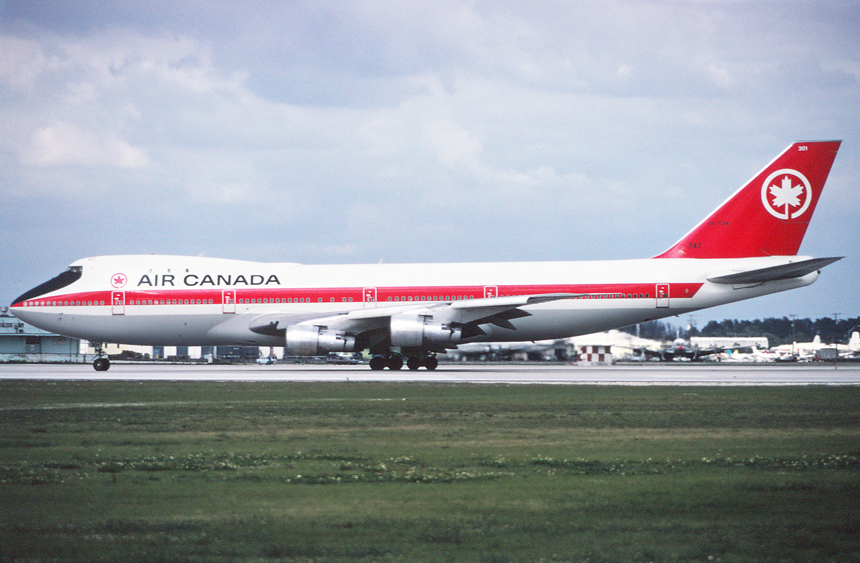
| February
1972 The residents of Canada enjoy escaping the occasional harsh winters of the Canadian landscape and venture to more warmer climates in the south and Caribbean. In 1966, Air Canada extended one of it's scheduled routes from Tampa to Miami and opening up the South, Florida vacation market. By 1970, Air Canada had added non-stop service from Miami to both Montreal and Toronto, including placing its new Boeing 747 "Jumbo Jet" on the service during the busy winter seasons. Seen taxiing toward Runway 9 Left for a mid-morning departure is CF-TOA, a Boeing 747-133 delivered new to the airline in January 1971. |
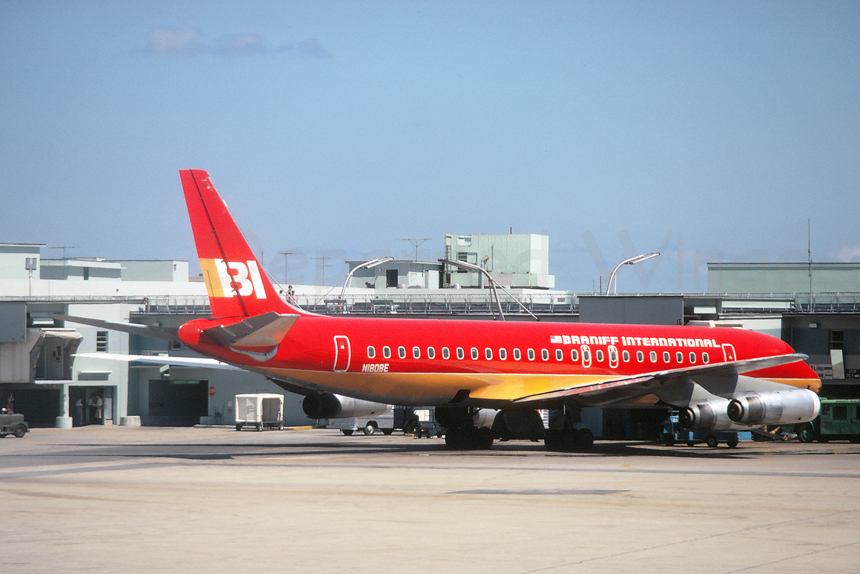
| March
1972 Flamboyant airline, Braniff International Airways introduced a new marketing campaign in 1971, known as the "Flying Colors of Braniff." Four new bold two-tone colors were introduced on the airline's Boeing 707s, Douglas DC-8s, and Boeing 727s over the next few years. Parked at the gate and wearing the Red/Aztec Gold colors is N1808E, a Douglas DC-8-62, delivered new to Braniff on October 23, 1969. |

| March
1972 Delta Airlines ordered five of the Boeing 747 airplanes for transcontinental services after receiving approval to start routes to the West Coast. The airlines first "Jumbo Jet" was delivered in September 1970, and scheduled services were inaugurated on an Atlanta-Dallas-Los Angeles route on October 25, 1970. As additional 747s were delivered, the 370-seat wide-body was placed on the popular routings to south Florida with flights to Miami from Atlanta, Chicago, Detroit, and Tampa. As with many of the airlines, Delta soon realized that in order to operate the 747 cost effectively, they needed large, consistent volumes of traffic and the transcontinental and Florida routes just couldn’t support the increasing costs of the 747. After much consideration and evaluation, it was decided that the 747 was not economical for the Delta route profiles and the last plane was removed from service in April 1977. Seen taxiing inbound toward the gate at Concourse E is N9897, a Boeing 747-132, delivered new to the airline in October 1970. |
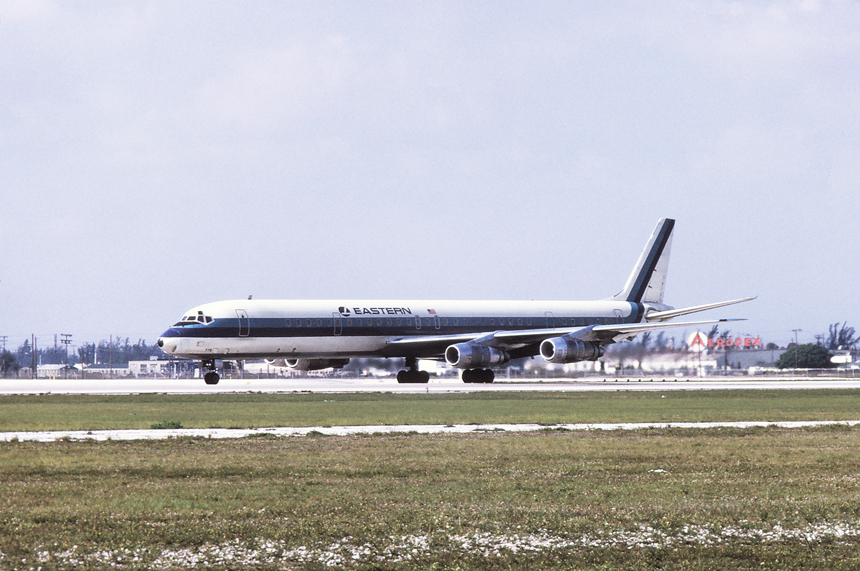
| April
1972 Caribbean Pleased with the Douglas DC-8 product, Eastern Airlines went on to order the "Super Sixty" series of the popular DC-8 in 1965. The new series -61 could carry up to 269-passengers and was suited for West Coast-Hawaii flights as well as Northeast to Florida and Caribbean routes. Eastern opted for an initial order of eight aircraft the first being delivered on March 3, 1967. Miami saw the DC-8-61 initially placed on the popular non-stop flights to New York-JFK. Seen turning onto Runway 9 Left for a mid-morning departure is N8775, a Douglas DC-8-61. This aircraft was subsequently involved in a crash while operating with Japan Airlines at Tokyo Haneda Airport on February 9, 1982. |
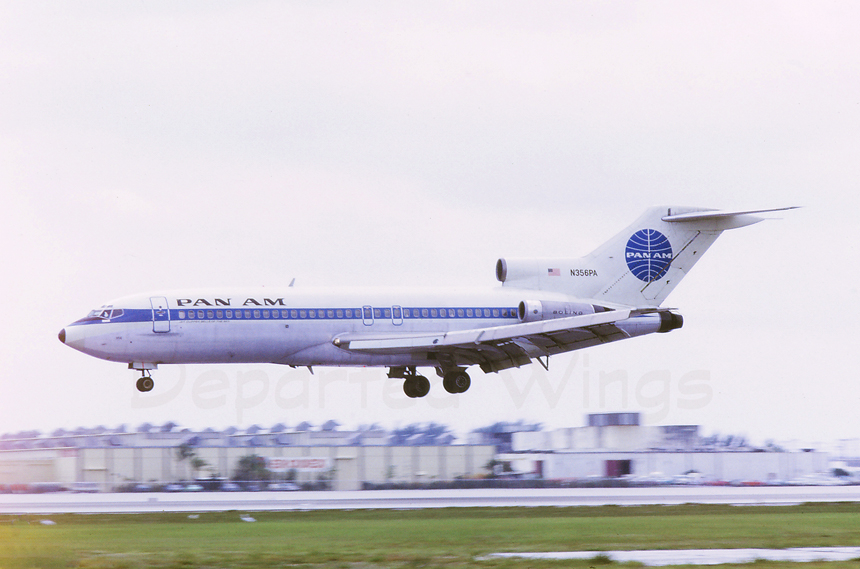
| April
1972 Pan Am continued to be a important carrier on flights from Miami to destinations in the Caribbean, Latin America, and South America. Boeing 707 and DC-8 aircraft were used on flights to South America and denser Caribbean routes. The Boeing 727 was used on services from Miami to St, Thomas, St. Croix, Port Au Prince, and Panama City. Seen on short final for landing on Runway 9 Left is N356PA "Jet Clipper Belle of the Sky," a Boeing 727-21. |
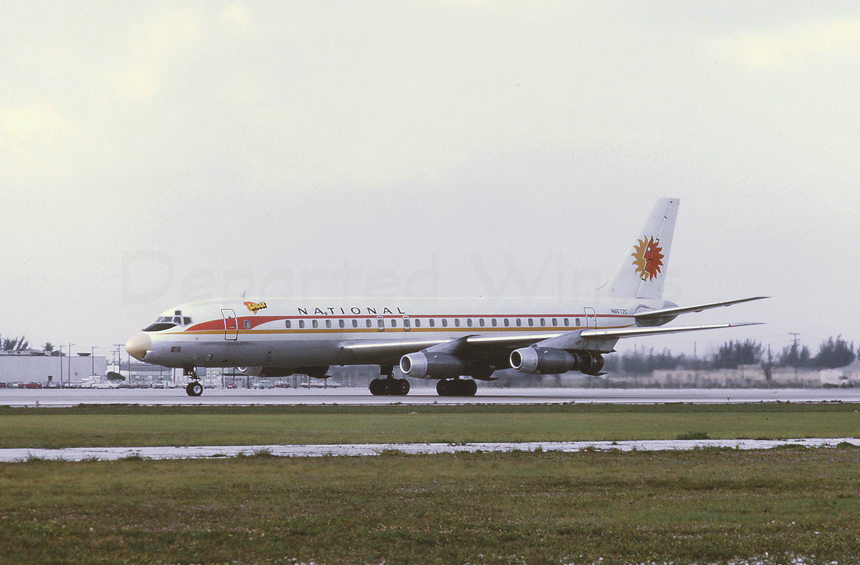
| April
1972 National Airlines received its first Douglas DC-8 in February 1960, and with the Boeing 727s delivered four years earlier transition to an all jet fleet. Miami saw the Douglas DC-8s placed on the lucrative New York-Idlewild route in 1960 with ten daily round-trip schedules. By 1972, having been in service over twelve years, the older DC-8s were still used on routes from Miami to Houston, New York-JFK, and Tampa. Seen holding in position for takeoff on Runway 9 Left is N6572C, a Douglas DC-8-21, delivered new to the airline on March 7, 1960. |

| February
1973 Overseas National Airways (ONA) based in New York was started as a supplemental carrier in 1950 to provide both passenger and cargo charters. Military charters provided the bulk of the airlines business through the 1960s and in 1968, eleven second hand Lockheed L-188 Electra's were purchased to provide both domestic and international cargo charters. Miami would see the Electra on cargo charters to both military and civilian destinations throughout the Caribbean. Parked on the north cargo ramp is N285F "Expediter," a Lockheed L-188A Electra purchased by the airline in January 1968. |
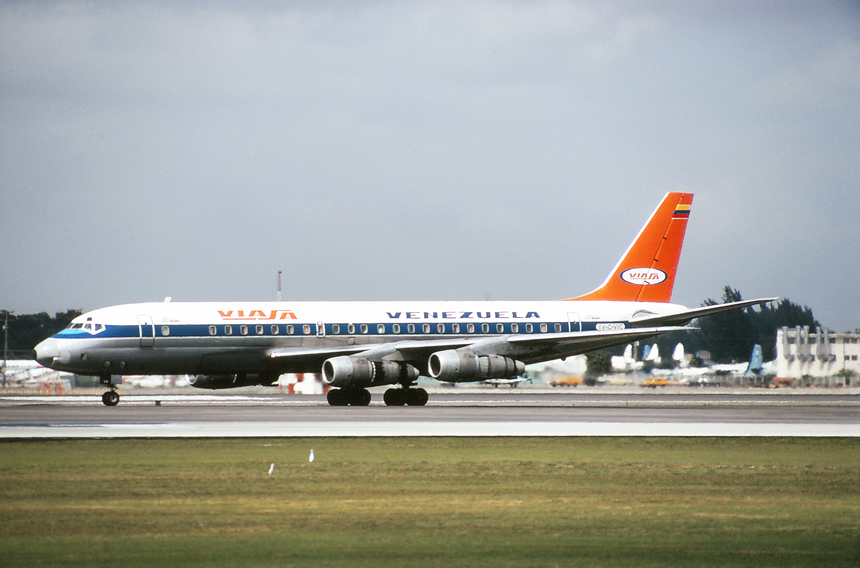
| April
1973 VIASA Venezuela was formed in 1960 to consolidate the routes of the existing Linea Aeropostal Venezolana (LAV) and AVENSA into a quasi private and government owned carrier. Flights to Europe and New York were started using the Convair 880 and eventually the old AVENSA route to Miami was added to the VIASA route map in 1961 with services to Kingston, Jamaica, Maracaibo, and Caracas. Seen taxiing out for a mid-morning departure is YV-C-VIC, a Douglas DC-8-54 delivered to the airline in July 1966. |
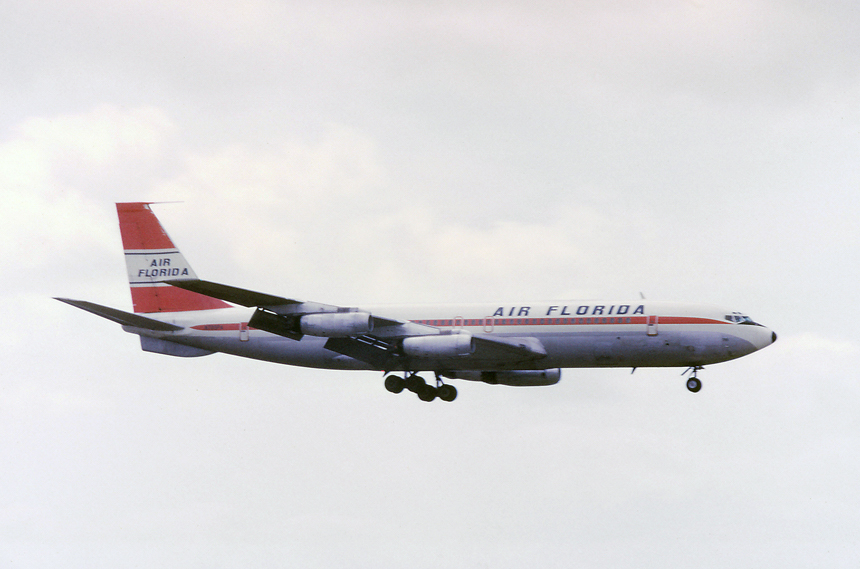
| April
1973 Florida's own "intra" airline Air Florida, started operations from a Miami base in September 1972. As an intrastate carrier the new airline was promoting low fares for various Florida destinations. Having purchased two ex-Pan Am Boeing 707s, the airline started flights between Miami-St. Petersburg, and Orlando. It was soon realized that the Boeing 707 were too large and uneconomical for the intrastate operation and were soon replaced with Lockheed L-188 Electras. Seen on approach to Runway 12 during an afternoon arrival is N705PA, a Boeing 707-331, delivered to Air Florida in October 1972 and in service with the airline for only nine months. |
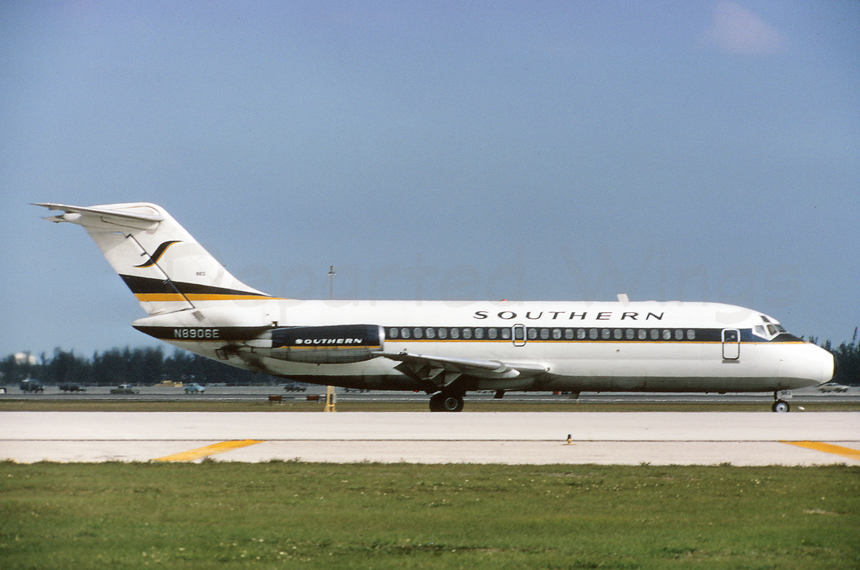
| April
1973 Southern Airways received permission to start "Route of the Aristocrats" service to Florida in February 1970 with flights from Birmingham and Montgomery to Orlando and Tallahassee. Miami was also added as an extension from Orlando using the Douglas DC-9. For the next six years Orlando would be the city served by Southern Airways until 1976 when the airline inaugurated service to Grand Cayman in the British West Indies from Miami. Southern would be the first U.S. airline to start service to Grand Cayman and would be the only international route the airline would operate. Seen taxiing toward the terminal after having landed on Runway 9 Right during an afternoon arrival is N8906E, a Douglas DC-9-14, originally with Eastern Airlines in July 1966. |
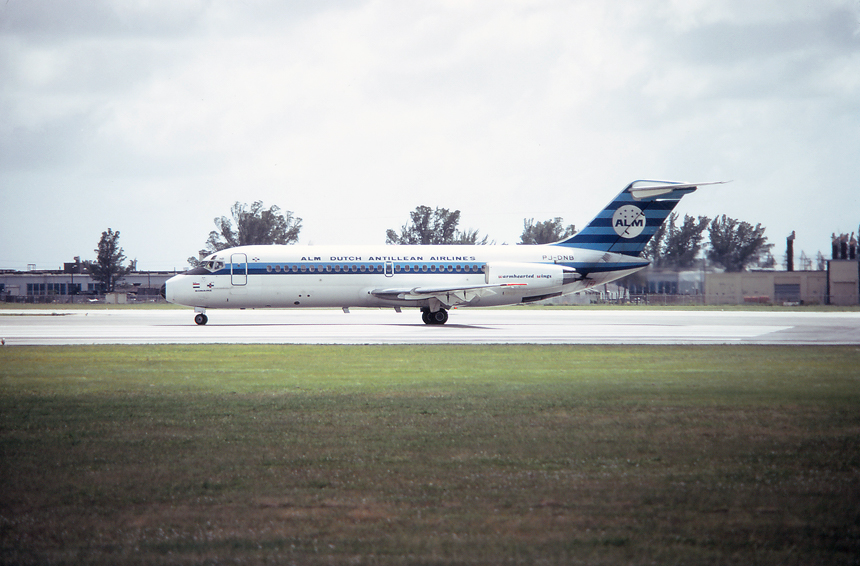
| November
1973 ALM Dutch Antillean Airlines was created by KLM Royal Dutch Airlines to provide regional service to the Dutch West Indies with in the Caribbean. Flights started in August 1964 using three Convair CV-340 aircraft from Curacao airport. As the tourist market grew, ALM replaced its piston-engined airplanes with new Douglas DC-9 jets. In 1970 flights were started to Miami from Curacao and Aruba via Kingston, Jamaica. Seen holding in position and awaiting takeoff clearance on Runway 9 Left is PJ-DNB, a Douglas DC-9-15 delivered to the airline in November 1968. |
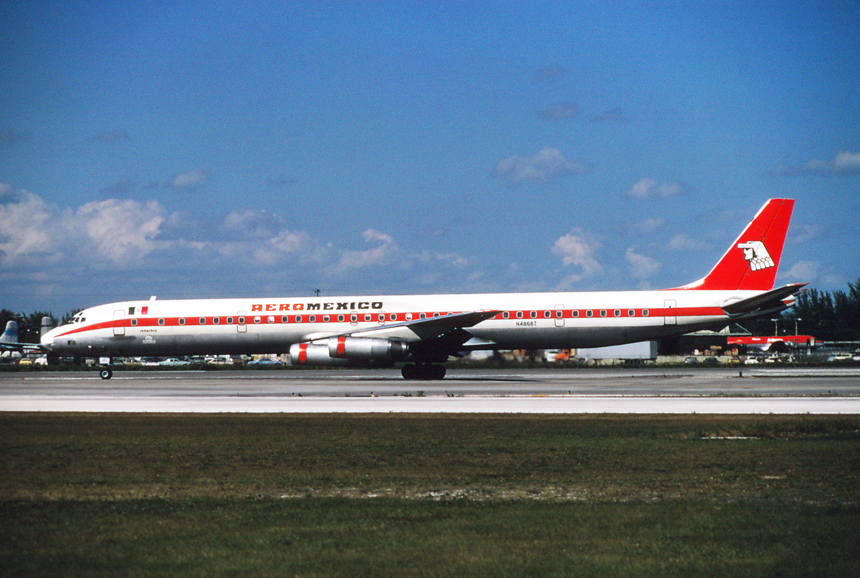
| December
1973 With a strong Latin connection to Miami, Aeromexico, the flag carrier of Mexico, started service into Miami during 1963, as a stop on the new Mexico City-Madrid, Spain route using Douglas DC-8s. This route would continue a decade later and use the Douglas DC-8 "Magno Jet" on the thrice-weekly trans-Atlantic route from Mexico City to Madrid via Miami. Seen taxiing toward Runway 9 Left for a mid-morning departure is N4866T "Veracruz," a Douglas DC-8-63CF, leased from Trans International Airlines in March 1971. |

| February
1974 As one of the oldest airlines in South America, Avianca Columbia, started operations in 1919 as SCADTA and had ownership and influence from Pan American Airlines. The airline started non-stop service between Miami and Bogota, Columbia in 1946 using a Douglas DC-4 and becoming the second South American airline to start service to the United States. Jet aircraft were introduced in 1961 with the Boeing 707 and routes to Miami expanded. Avianca introduced Boeing 727 service in 1966 for domestic and regional routes including on services to Miami from Barranquilla and Cartagena, Columbia. Seen holding in position for takeoff on Runway 12 is HK-727, a Boeing 727-59, appropriately registered as Avianca's first 727 delivered in march 1966. |

| February
1974 A unique "commuter" was created for the planned real estate development of Marco Island located on the west coast of Florida. Deltona Corporation created a vacation resort in the 1960s and built an airport to provide the needs of vacationers and potential investors viewing properties. In 1972, Deltona created Marco Island Airways to provide airline service to the island initially using a fleet of three Beech 99 turboprop aircraft. The only route the airline flew during the 1970s, was the three-times daily Miami-Marco Island service used by both vacationers and homeowners. Parked on the ramp and awaiting its next load of passengers is N1922T, a Beech B-99A |
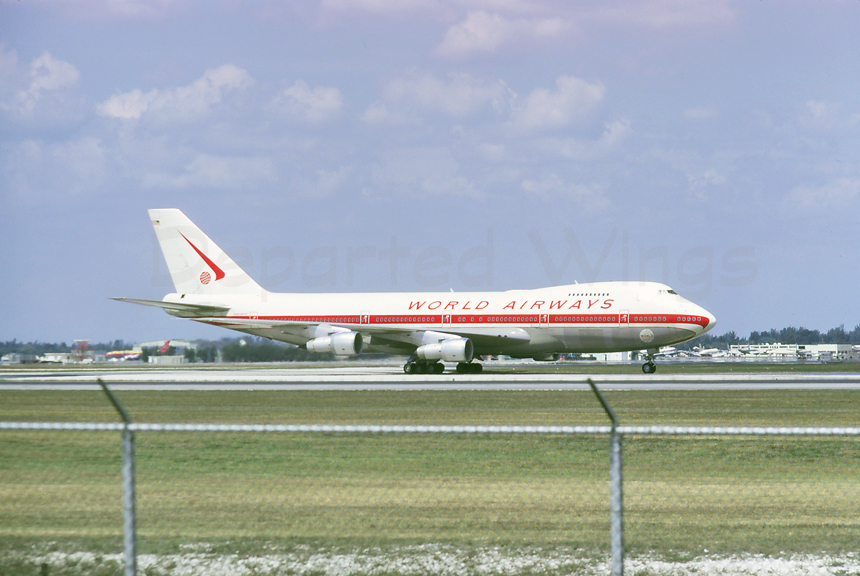
| March
1974 World Airways became the launch customer for the Boeing 747 convertible cargo version with the "flip-up" nose that makes for more efficient loading of bulk and larger cargo pallets. As one of the largest carriers for government and military contract charters, the ability to convert the large 747 from a all-cargo to an all-passenger configuration gave World Airways lots of flexibility weather transporting military troops or equipment. Their first convertible Boeing 747 was delivered in April 1973, and this was followed by two additional airframes. Seen rolling for takeoff on Runway 12 is N747WA, a Boeing 747-273C, delivered new to the airline on April 27, 1973. |
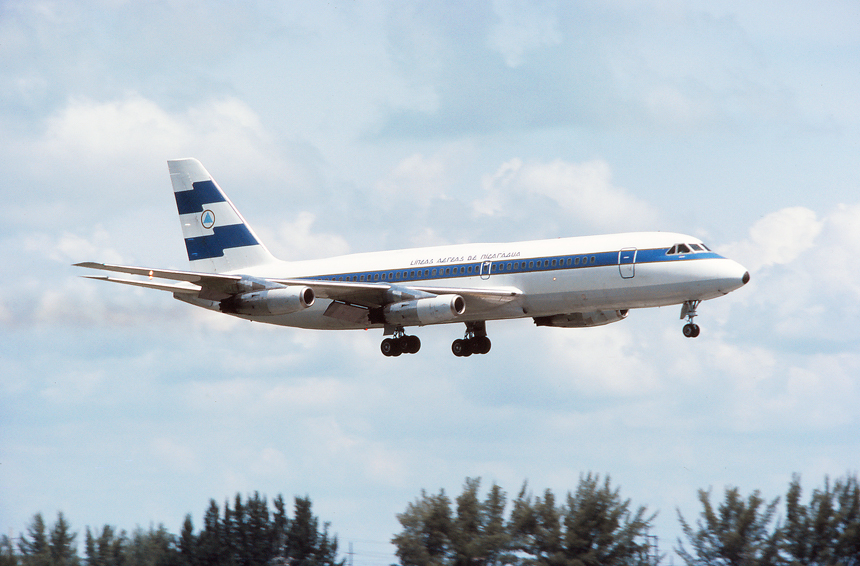
| May 1974 Lineas Aereas de Nicaragua of LANICA was formed in 1945 as a subsidiary of Pan American Airways to provide service domestic services within Nicaragua using a Douglas DC-3. In 1957, flights were started connecting Miami with Managua using a Douglas DC-6, the Vickers Viscount. Jet flights commenced in November 1966, when the airline introduced the British Aerospace BAC-1-11 on a Managua-San Salvador-Miami route. In 1972, the airline purchased its first of four Convair CV-880 aircraft for use on the popular daily service from Miami to both San Salvador and Managua. Seen on short final to Runway 9 Right during a spring morning is AN-BLW, a Convair CV-880-22-2, originally delivered to Delta Air Lines in December 1960. |
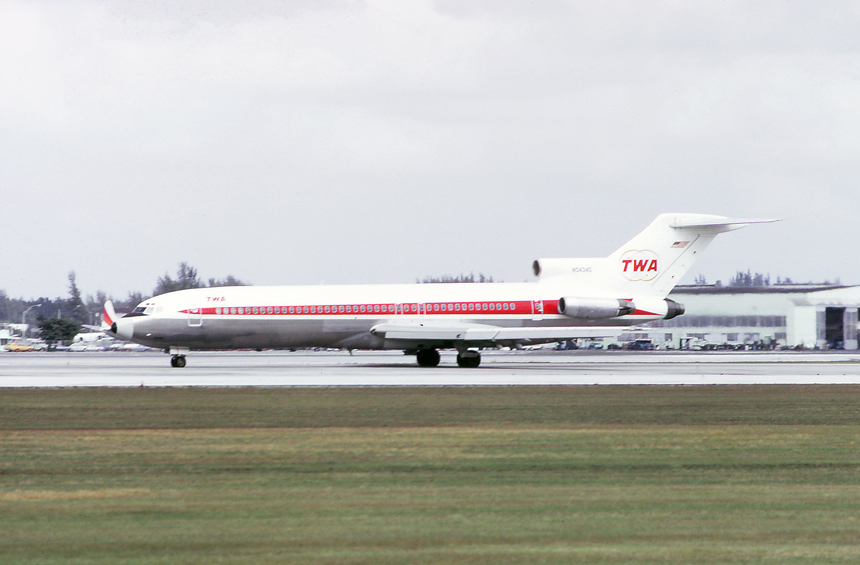
| January
1975 Trans World Airlines TWA, received permission to start service to Florida in January 1959 with flights from Miami to Orlando and St. Louis using the Lockheed "Super G" Constellation. For the next fifteen years the Miami to Orlando and St. Louis service were the only flights operated by TWA eventually placing Boeing 727 jet service on the route in the mid-1960s. Taxiing out for a mid-day departure is N54340, a Boeing 727-231 delivered new to TWA a few months earlier on September 10, 1974. |
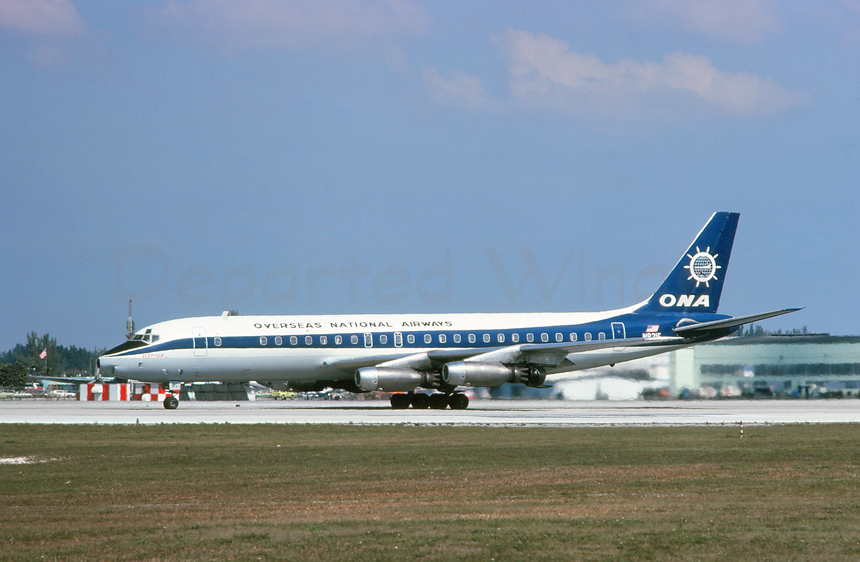
| March
1975 During the 1970s Overseas National Airways ONA, upgraded its fleet to jet aircraft with the Douglas family of airframes including the DC-8 DC-9, and the Douglas DC-10. As a supplemental airline, ONA flew various military and contract charters world-wide using the Douglas DC-8 and DC-10s on passenger operations. Taxiing out toward Runway 9 Left for an afternoon departure is N821F "Scepter," a Douglas DC-8-21, delivered new to the airline on September 18, 1973. |

| April
1975 Delta Air Lines had selected the Lockheed L-1011 to provide capacity and range yet be smaller then the Boeing 747. Placing an order for the L-1011 in 1968, the plane was soon plagued with production delays and the bankruptcy of engine manufacturer Rolls Royce. To maintain a competitive edge, while waiting for deliveries of the Lockheed, Delta placed an order for five of the competitors Douglas DC-10. Delta's first DC-10 was put into service on December 15, 1972 between Atlanta and New York-La Guardia. Miami would soon see the Tri-Jets on daily, non-stop services to both Chicago and Detroit. Seen turning onto Runway 9 Right for a mid-morning departure is N604DA, a Douglas DC-10-10. |
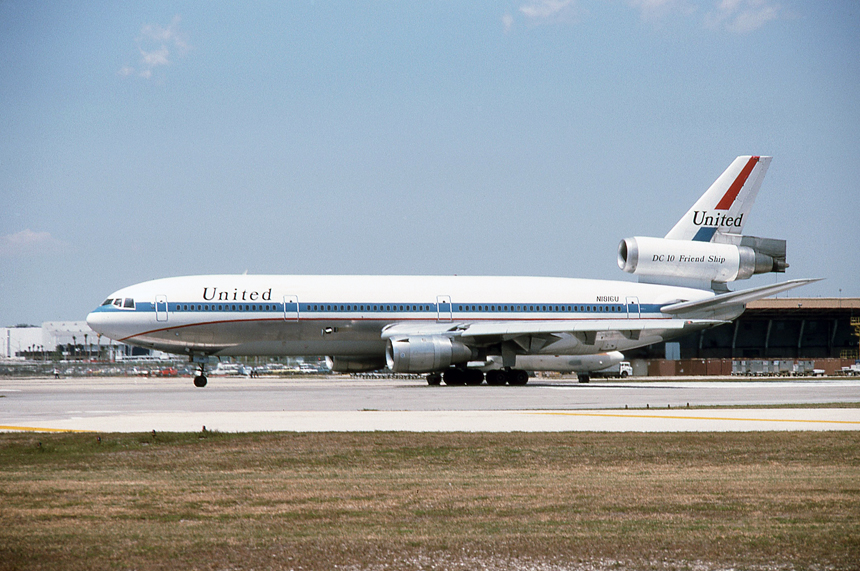
| April
1975 Seeking routes to Florida, United Air Lines purchased Washington D.C. based Capital Airlines in June 1961 to open route opportunities to the "Sunshine" state. Although Capital was flying numerous routes from Florida to the Northeast, United Air Lines initially maintained routes from Miami to Jacksonville, Tampa, and Pittsburgh. By 1975, United was using its "Heavy 10s" on daily services to both Cleveland and Pittsburgh. Seen taxiing outbound for takeoff on a bright spring morning is N1816U, a Douglas DC-10-10 delivered new to the airline in March 1973. |

| August
1975 Continental Airlines, after years of legal battles finally received authority after to start service to Miami in 1974. The single route between Houston-Intercontinental and Miami would initially use a Boeing 720 on the thrice daily service. Aside from National Airlines, the "Proud Bird with the Golden Tail" was the only other airline providing service to Houston-Intercontinental and could feed into Continental's growing hub operation. Seen "over-the-numbers" for landing on Runway 9 Right is N57206, a Boeing 720-024B. |

| November
1975 Eastern Airlines and Trans World Airlines (TWA) were the official launch customers for the "Space-Age" Lockheed L-1011 and ordered fifty of the aircraft in 1968. Their first plane was delivered on April 6, 1972, and service was started a few weeks later, on April 30 between Miami and New York City with a stop in Atlanta. Eastern dubbed the new wide-body "Whisperliners" for their quiet takeoff and low-noise cabin. Miami was a "hub" for Lockheed L-1011 operations with the airline flying to eight domestic destinations using the Tristar including flights to the three New York airports; JFK, La Guardia, and Newark. Holding in position for takeoff on Runway 12 and wearing the Bicentennial sticker to celebrate the United States 1976 Bicentennial is N305EA, a Lockheed L-1011-385-1, delivered to the airline in November 1972. |
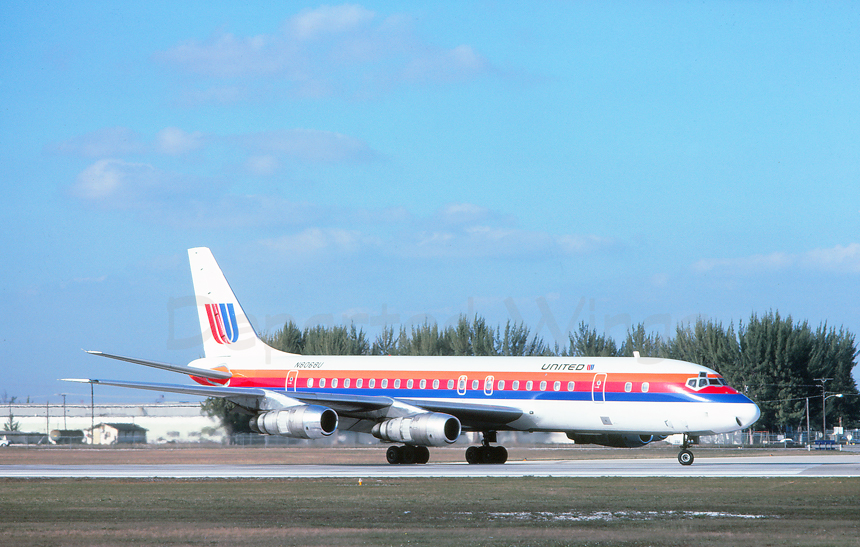
| November
1975 By 1975, United Airlines original Douglas DC-8 fleet had been in service for sixteen years and were slowly being replaced by Boeing 727 and 737 airframes. Some of the older Douglas DC-8s even received the new Saul Bass tri-color scheme introduced in 1974. United flights had transitioned to Boeing 727 and Douglas DC-10 flights into Miami however the Douglas DC-8 was occasionally substituted on services to Cleveland and Pittsburgh. Seen turning onto Runway 9 Right for a morning departure is N8068U, a Douglas DC-8-52, delivered new to the airline in May 1966. |
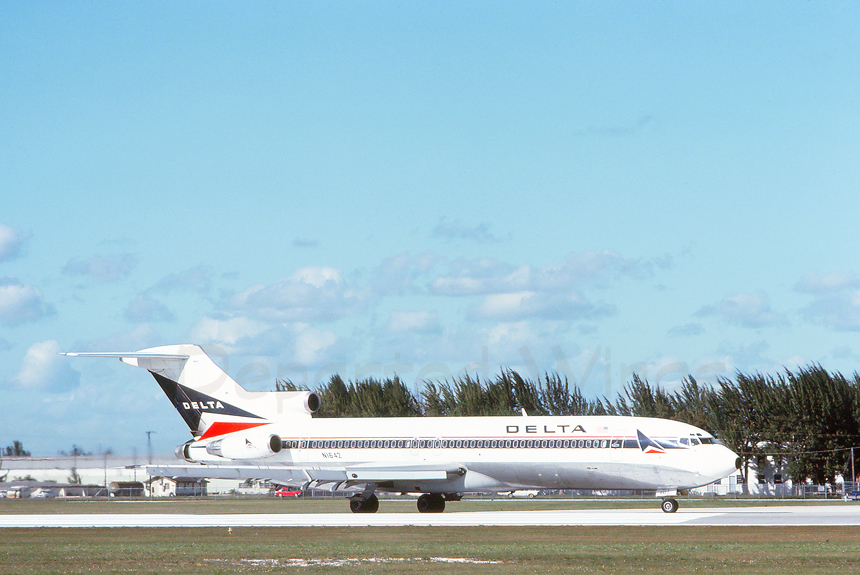
| November
1975 Delta Airlines introduced the Boeing 727 when the airline acquired Northeast Airlines and their existing Boeing 727s in August 1972. Delta saw the Boeing 727 as a reasonable aircraft to operate short to medium range routes and land at airports with shorter runways. The airline initially ordered fourteen of the -200 "Advanced Stretch" version in 1972. With a configuration of 131-passengers, Miami saw Delta's Boeing 727s being used on routes to Atlanta, Jacksonville, Memphis, Philadelphia, and Tampa. Seen taxiing into position for takeoff on Runway 9 Right on a bright fall morning is N1642, a Boeing 727-295, originally with Northeast Airlines. |
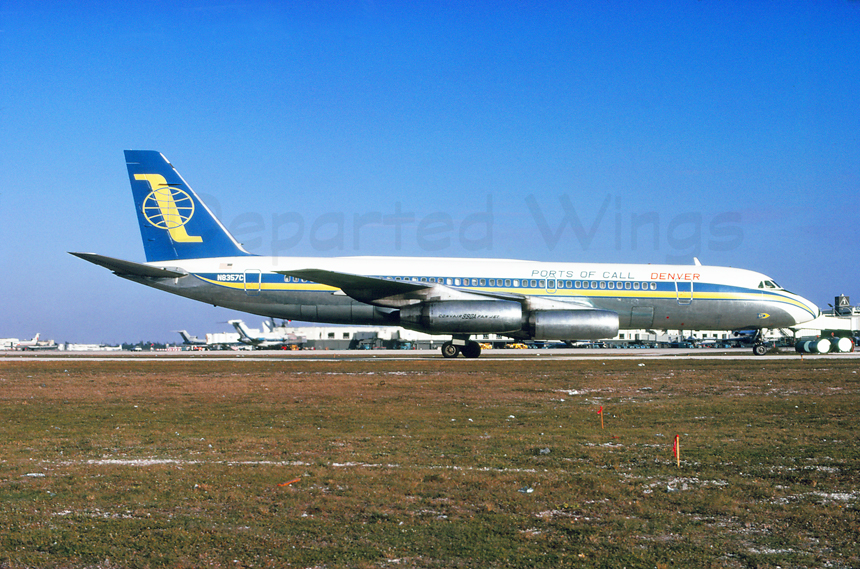
| January
1976 During the As the largest member based air travel club in the United States, Denver based Ports-of-Call aircraft could be seen around the world on club flights. One popular destination for the club was "Snow-Bird" flights to warm and sunny southern Florida during the harsh Colorado winter months. Shown parked on the ramp during a winter charter flight is N8357C, a Convair CV-990-30A-5 Coronado. |
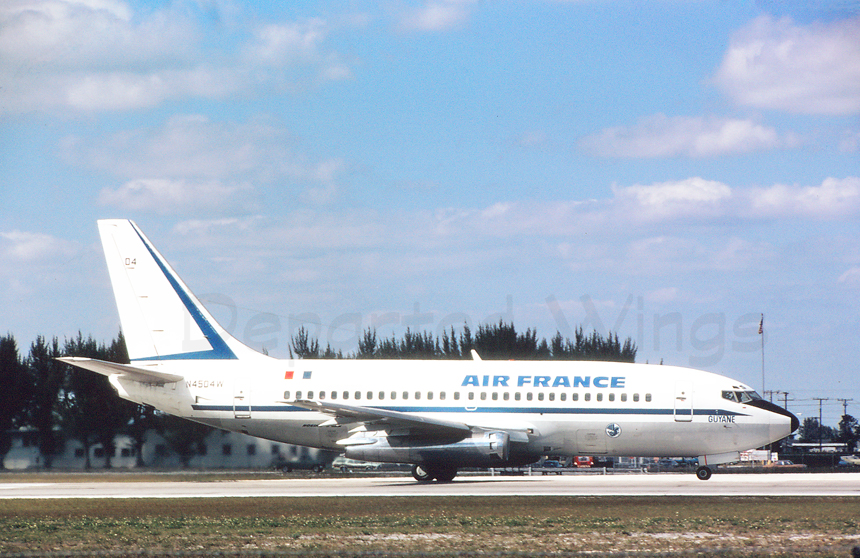
| March
1976 Air France had introduced service to Miami in 1968, not to Paris however, but to Port-au-Prince, Haiti using a Sud Aviation Caravelle. The national airline of France, has set up a network of routes in the Caribbean, focusing operations on past French colonies and protectorates and had extended flights to Miami from the ex French territory of Haitian Hispaniola. The daily flight utilized a Boeing 737 to Port-au-Price which then continued on to San Juan, Puerto Rico. Seen holding in position on Runway 9 Right for a morning departure is N4504W, a Boeing 737-247, originally with Western Airlines and purchased by Air France in January 1974. |

| March
1976 In the months leading up to the United States Bicentennial in 1976, the country held a series of events and observances to commemorate the 200 year anniversary of the founding of our independent republic. Some airlines participated in the yearlong event, with two in particular, both Eastern Air Lines and Delta Airlines which incorporated patriotism uniquely into their images. Eastern designed a “Historic Flags of America” emblem that would be applied to its aircraft to celebrate the bicentennial. The emblem portrayed the evolution of the nation’s flags and included nine designs encircling a yellow badge stating “…what so proudly we hail” with the dates 1776 and 1976. The emblem was placed on the forward fuselage merged with the lower “Ionosphere Blue” stripe. The bicentennial logo brought Eastern positive visibility during a proud moment in the history of the United States. Seen taxiing into position for takeoff on Runway 9 Right for a mid-day departure is N8129N, a Boeing 727-25, delivered new to Eastern Air Lines in April 1965. |
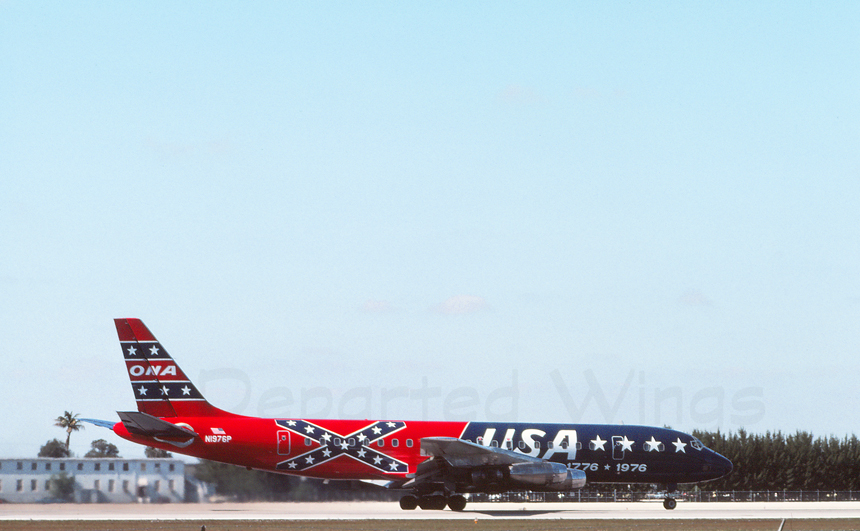
| May
1976 As a few airlines such as Delta Airlines and Eastern Airlines did their part to celebrate the American 200 year anniversary of independence, or Bicentennial of 1976, Overseas National Airways (ONA) decided to dedicate two of its aircraft to a full patriotic color scheme. Two aircraft were painted; one on the familiar stars-and-strips, and the second in representation the Confederate Flag and battles of the American Civil War. Both aircraft were seen on various ONA charters world-wide and helped promote the important American celebration. Seen holding in position for takeoff on Runway 9 Right and wearing the appropriate registration of N1976P, is a Douglas DC-8-21, originally delivered to Eastern Air Lines in August 1961. |

| June
1976 Oakland, California based charter airline Trans International Airlines (TIA) was established in 1947, by entertainment mogul Kirk Kerkorian. Starting as a small charter carrier shuttling passengers from Los Angeles to Las Vegas, the airline grew quickly to become one of the largest charter operators in the world. Realizing many of its charter contracts were military, the airline introduced "jet" Douglas DC-8 trans-Pacific service in 1965, becoming the first charter airline to operate jet aircraft. By 1976, Trans International Airlines was flying twelve Douglas DC-8s, as well as the Douglas DC-10. Seen taxiing out toward Runway 9 Left on a mid-morning charter departure is N4869T, a Douglas DC-8-63CF. |
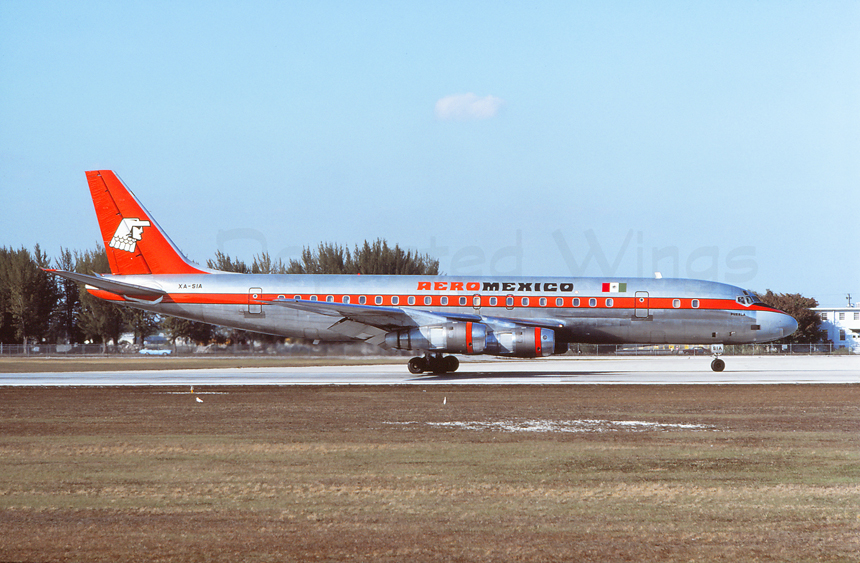
| August
1976 Aeromexico had received two Douglas DC-10s in 1974 for long range service, however the Douglas DC-8s continued to play a role in both international and domestic Mexico services. In 1976, Aeromexico continued to use Miami as a intermediate destination on its Mexico City-Madrid route, and the only routes to be served from the airline at Miami during that time. Seen holding in position for takeoff on Runway 9 Right is XA-SIA "Puebla," a Douglas DC-8-51. |
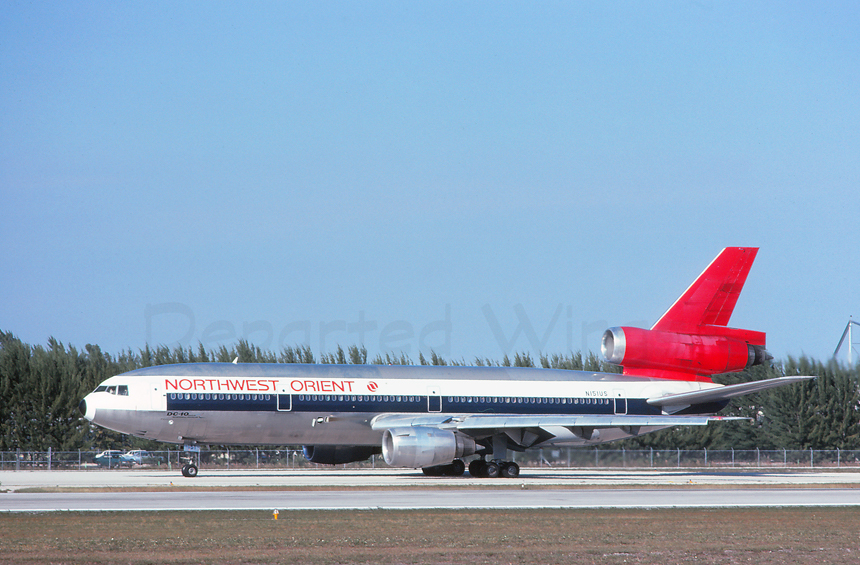
| October
1976 Northwest Orient Airlines started service into Miami initially as an interline agreement with Eastern Air Lines via Chicago and Atlanta and 1954. Four years later in 1958 Northwest added its own service from Chicago to Miami, eventually adding service to both Tampa and Ft. Lauderdale using Lockheed L-188 Electra's. By 1975, Northwest had non-stop service to four destinations, and especially during the busier winter season was using its 281-passenger Douglas DC-10s on daily flights to Atlanta, Chicago-O'Hare, Cleveland, and Minneapolis-St. Paul. Seen taxiing toward Runway 9 Right for an afternoon departure is N151US, a Douglas DC-10-40. |

| October
1976 Along with Eastern Airlines and other airlines, Delta Airlines promoted the United States Bicentennial anniversary by decorating many of its aircraft with a patriotic symbolism. The Delta "widget" had stars and stripes applied along with the slogan; "We the People 1776-1976." Seen holding in position on Runway 9 Right for a mid-morning departure is N3337L, a Douglas DC-9-32. |

| February 1977 Cayman Airways was established in August 1968 with a majority government purchase of LACSA Costa Rica owned Cayman Brac Airways. International service to both Kingston, Jamaica and Miami, Florida utilized the Douglas DC-6 until the airline leased a BAC-1-11 Jet from LACSA in 1973. By 1977, Cayman Airways was scheduling a daily flight between Miami and Grand Cayman. Seen holding in position for takeoff on Runway 9 Right is TI-LRJ, a British Aerospace BAC-1-11-531FS. |

| February 1977 Looking to increase capacity on its most important international routes, including the flagship Miami-Bogotá route, Avianca Columbia, leased a Boeing 747 in November 1976. Additional Boeing 747s were delivered to the airline in 1979, and the early 1980s allowing the airline longer-range, higher capacity route to the United States and Europe. Seen taxiing out toward Runway 9 Left for an afternoon departure is HK-2000 "Eldorado," a Boeing 747-124, leased by Avianca in November 1976, and originally delivered to Continental Airlines in July 1970. |
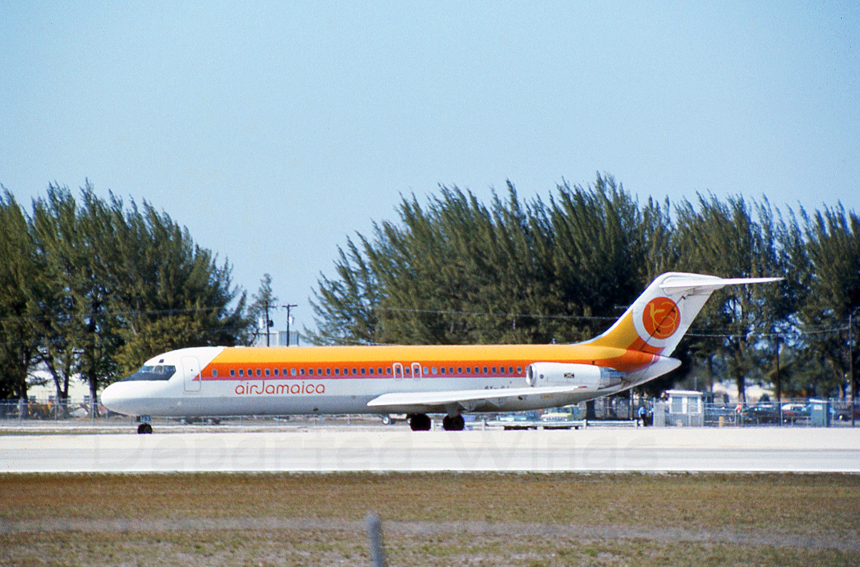
| March
1977 The flag carrier of the Caribbean island of Jamaica, Air Jamaica, was started in August 1963, with international services commencing from Kingston to both new York and Miami on May 1, 1966. Two Douglas DC-9s were acquired for early service and these continued to be used on daily flights to Miami from both Kingston and Montego bay during 1977. Seen holding short of Runway 9 Right for an early afternoon departure to Montego Bay is 6Y-JIJ, a Douglas DC-9-32, delivered new to the airline on June 28, 1974. |
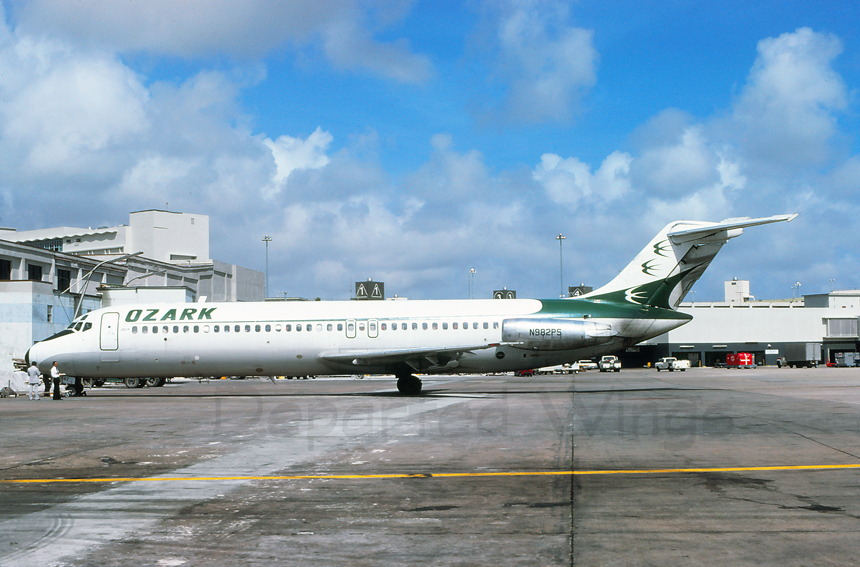
| April 1977 St. Louis based Ozark Air Lines wouldn't start scheduled service into Miami and Florida destinations until after deregulation in 1978. Prior to that the airline was occasionally seen at Miami on charter flights for both sports teams and vacation package contracts from various Midwest locations. Parked at the terminal complex during a spring charter flight is N982PS, a Douglas DC-9-31, purchased by Ozark in July 1969, and delivered new to Pacific Southwest Airlines PSA on January 24, 1968. |
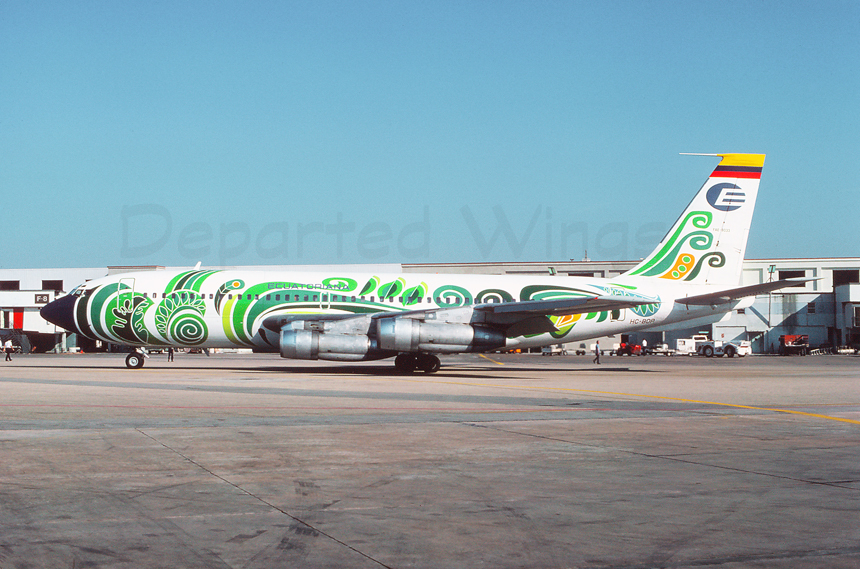
| April
1977 The national airline of the South American country of Ecuador, Ecuatoriana was established when the government purchased the assets of previous airline; Compania Ecuatoriana de Aviacion in July 1974. The flagship route to Miami from Quito using the Boeing 707 continued. In an effort to promote the airline and compete with the "Flying Colors" Braniff International, five of their aircraft were painted in bold, regional inspired designs. Having just been pushed back from the terminal for a morning departure is HC-BDP "Napo," a Boeing 720-023B, representing the lush jungles and vegetation of it's native country. |
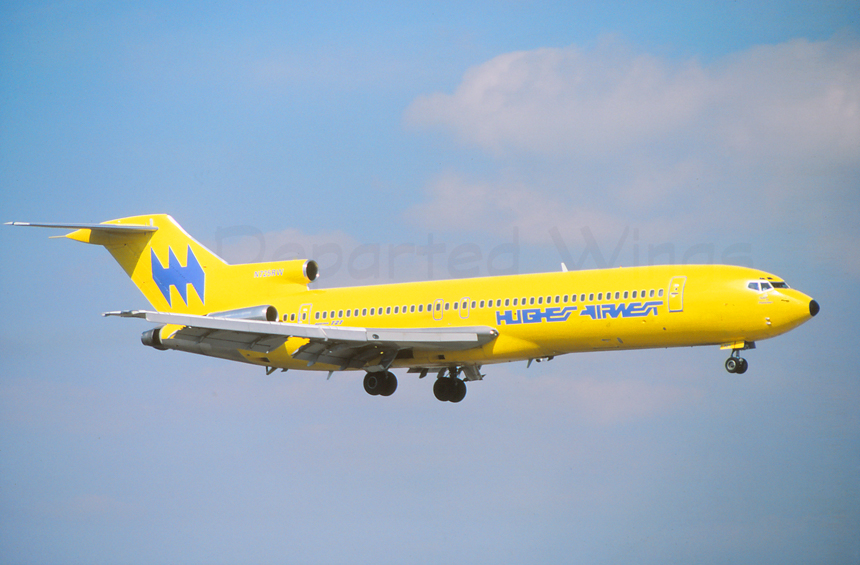
| July
1977 San Francisco based Hughes Airwest did not have scheduled service to Miami, however its Boeing 727s were used frequently on sports charter flights across the United States and were seen at Miami on both professional baseball and football charter flights from the West Coast. Seen on short final to Runway 12 is N725RW "Spirit of Patriotism," a Boeing 727-2M7(A). |

| August 1977 Aerocondor Columbia was a private funded airline that was founded in 1955 in Barranquilla, Columbia to provide cargo services throughout the country. Realizing an opportunity to provide passenger services the airline saw its Douglas DC-3s, DC-4s, and DC-6s reconfigured and international services started to Miami, Florida in 1963. Aerocondor introduced "jet" services in 1972 using a Boeing 720B on non-stop services between Miami and Barranquilla. By 1977, the airline had added additional routes from Miami to both Medellin and Bogota. Seen taxiing toward the terminal after having landed is HK-1818, a Boeing 707-123, purchased by Aerocondor in March 1976, and originally delivered to American Airlines on April 23, 1959. |
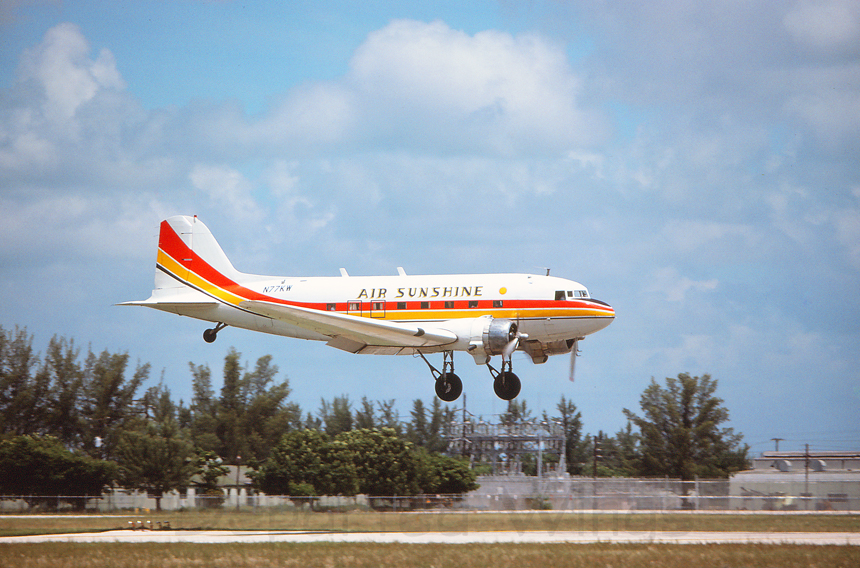
| August 1977 Air Sunshine started operations as American Air Taxi AAT in 1968, based in Key West and providing flights between the Keys, and Miami, Orlando, and Tampa. The airline became Air Sunshine in 1974, and had a small fleet of Douglas DC-3 and Convair CV-440s providing service to the Florida Keys. In 1977, the small airline was providing no less then fifteen daily flights from Miami to Marathon, Key West, and Orlando. Seen over-the-numbers for landing on Runway 9 Right is N77KW, a Douglas C-47A-5-DK. |

| August 1977 Delta Airlines received its first Lockheed L-1011 in October 1973, and started passenger service with the "space-age" aircraft on December 15, 1973. With a capacity of 250-passengers in a two-class layout, Miami was one of the first to host the L-1011 on flights to Atlanta and New York. Seen holding short of Runway 9 Right for a mid-morning departure is N705DA, a Lockheed L-1011-385-1 Tristar 1, delivered new to the airline on April 11, 1974, |

| August 1977 Braniff International continued to be a major airline at Miami especially as the only carrier with more daily departures to South America then any other, serving no less then seven destinations from the airport including, Lima, Buenos Aires, Santiago, and Bogotá. Seen rolling out on Runway 27 Left during a mid-day arrival is N1808E, a Douglas DC-8-62, delivered new to Braniff International on October 23, 1969. |
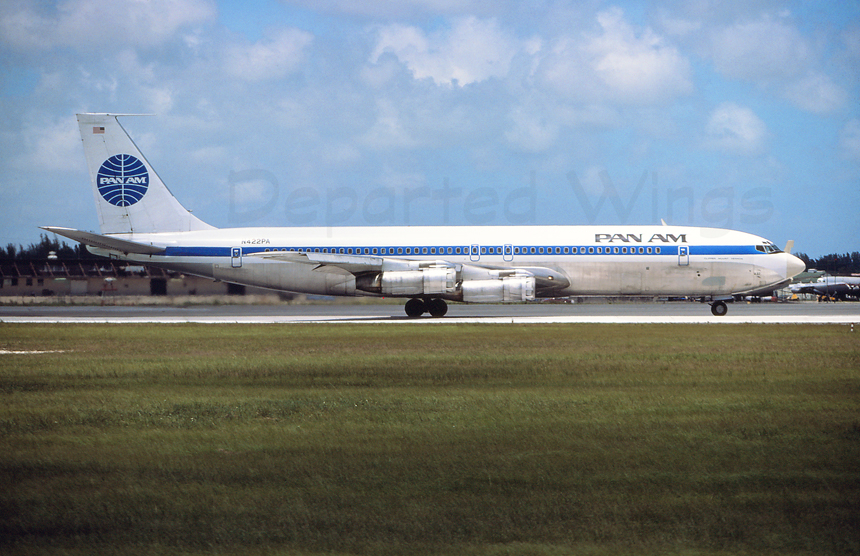
| August
1977 By the late 1970s, some of the Pan Am Boeing 707 fleet having been in service for almost twenty years was still a solid airframe and was being used on numerous flights throughout it's international network. In 1977, Pan Am's Boeing 707s were scheduled on flights from Miami to Panama City, Port-au-Prince, Madrid, and Guatemala City amongst others. Seen holding in position for takeoff on Runway 12 is N422PA "Clipper Mount Vernon," a Boeing 707-321B, delivered new to the airline on June 28, 1967. |
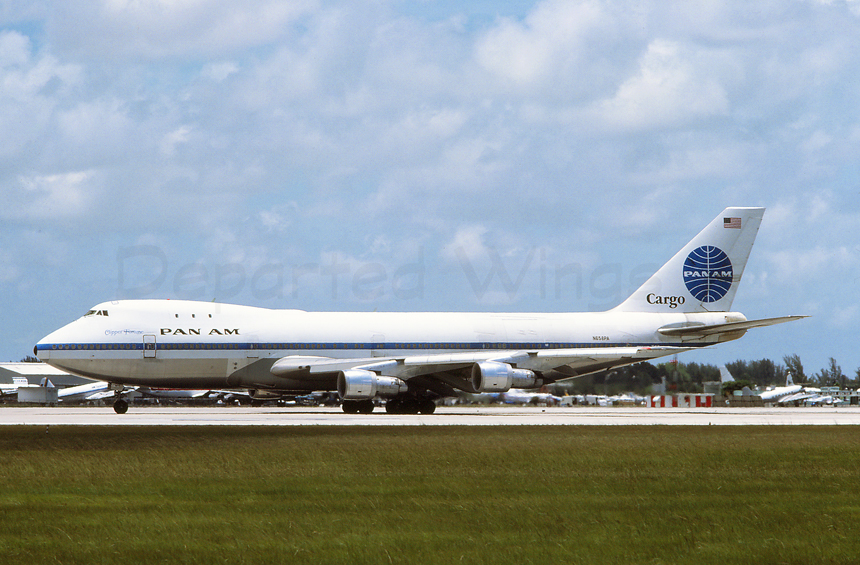
| August
1977 The all-cargo division of Pan Am was started in 1952 with initial flights using the Douglas DC-4, followed by Douglas DC-6 freighters for trans-Atlantic cargo service. Eventually "Jet" Cargo service was started with the Boeing 707 in 1963, and in 1975 the airline converted six Boeing 747s to full freighter configuration. Being a large cargo gateway to South America, Miami saw the larger Pan Am Cargo 747s on routes to Sao Paulo and New York-JFK. Seen taxiing out for takeoff on a bright summer afternoon is N658PA "Clipper Fortune," a Boeing 747-121(F) converted to a freighter in 1976. |
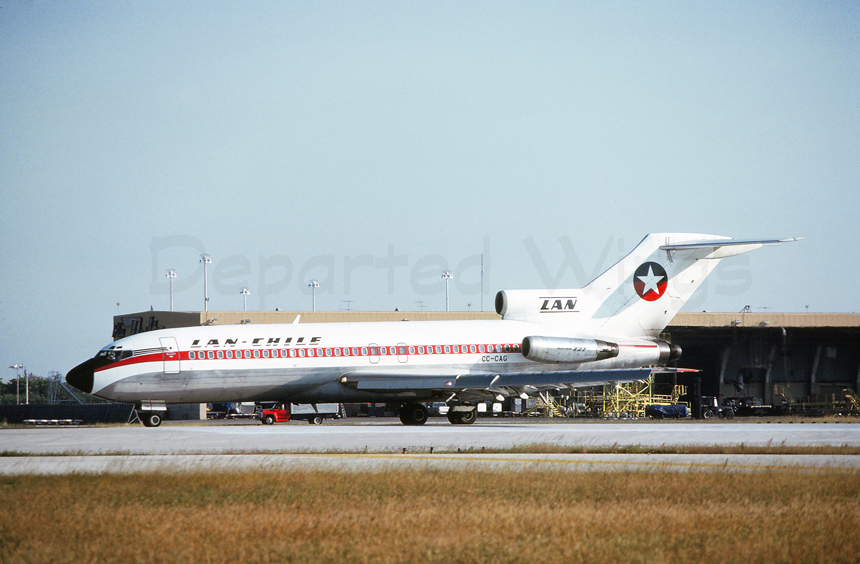
| October
1977 The national flag carrier of the South American country of Chile, Lan-Chile was formed in 1929 using a fleet of de Havilland Moth aircraft. Lan-Chile started scheduled passenger flights to Miami in 1958 using the Douglas DC-6. Jet service was started in 1963, when the airline started flying a Sud Aviation SE-210 Caravelle which was followed a few years later by the Boeing 707 and Boeing 727. By the mid-1970s Lan-Chile was serving multiple destinations from Miami, including Santiago via Lima, continuing flights to new York City, and flights to Cali, Guayaquil, and Panama City. Seen taxiing out toward Runway 9 Right for an early morning departure is CC-CAG, a Boeing 727-166, delivered new to the airline on February 6, 1968. |

| October 1977 By 1977, intra-state airline, Air Florida had grown to serve eleven destinations with the state of Florida using a small fleet of Douglas DC-9s. In an effort to promote its service the airline started an advertising campaign called the Air Florida KISS (Keep It Sweet and Simple) which also included bright red lips on the nose of their aircraft. Seen taxiing outbound for departure on a bright fall afternoon, and displaying the KISS lips under the cockpit is N60AF, a Douglas DC-9-15RC, purchased by Air Florida and delivered on June 9, 1977. |
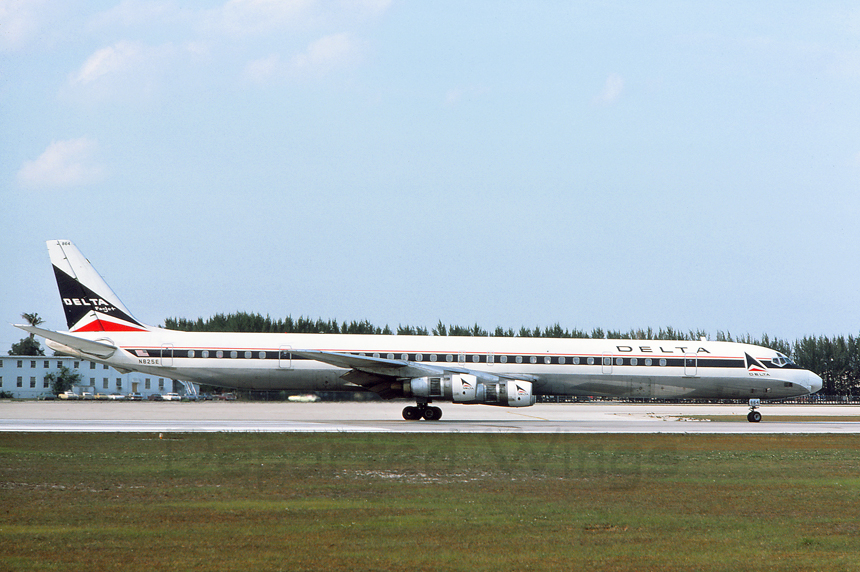
| October 1977 Delta Airlines having been pleased with the performance and operating economics of the Douglas DC-8, placed an order for the stretched -61 series and placed the aircraft in service in April 1967. With a seating capacity of 195-passengers in a two-class configuration, Delta's DC-8-71 were seen on various services from Miami including flights to Atlanta, Chicago, Tampa, and West Palm Beach during the late 1970s. Seen holding in position for takeoff on Runway 9 Right is N825E, a Douglas DC-8-61, delivered new to the airlines on January 24, 1968. |

| November 1977 Ecuatoriana continued to bring much positive attention to itself with its five bold aircraft color schemes representing the various regions of Ecuador. Seen holding short of Runway 27 Left for a early morning departure is HC-AZP, a Boeing 720-023B, wearing the "Galapagos" colors, representing the diversity of both plants and animals of the volcanic Pacific islands chain. |
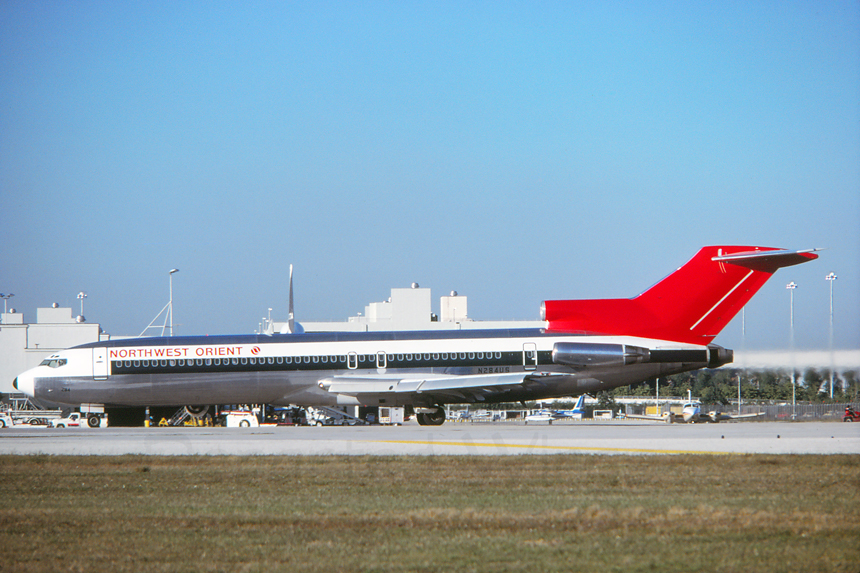
| January
1978 Northwest Orient introduced the "stretch" -200 version of the Boeing 727 on October 27, 1968 being used on short and medium range domestic routes. During the late 1970s, Northwest Orient was using the Boeing 727-200 on flights to both Chicago-O'Hare, and Tampa. Seen taxiing toward the terminal is N284US, a Boeing 727-251, delivered new to the airline on August 9, 1977. |

| February
1978 Air Canada placed an order for the Lockheed L-1011 in 1968, for added capacity on transcontinental Canadian routes as well as high-density services to Florida. The first aircraft for Air Canada was placed in service on March 15, 1973 between Montreal and Vancouver. The L-1011 was placed on scheduled flights between Miami and both Toronto and Montreal, supplementing the Boeing 747 especially during the busy winter season. Seen taxiing toward the terminal after having landed is C-FTNB, a Lockheed L-1011-385-1-14 Tristar. |
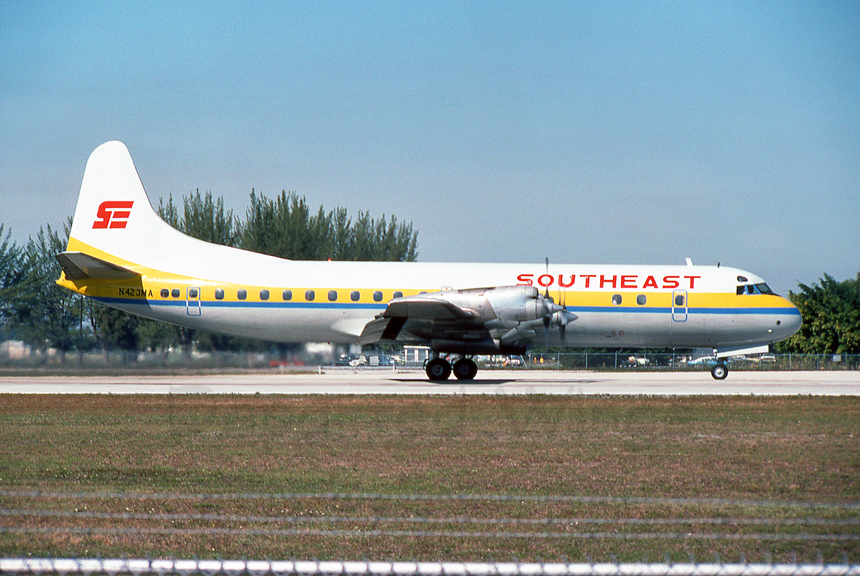
| February
1978 Miami based Southeast Airlines started service in the 1960s providing flights from Miami to various points in Key West. Over the next decade the airline expnded services and added various types of aircraft for both charter and scheduled passenger operations. In October 1977, the airline leased a Lockheed L-188 Electra for new service to the Turks and Caicos and increased capacity. The Electra was in the fleet for only a year before being returned to the lessor in October 1978. Seen holding in position for takeoff on Runway 9 Right is N423MA, a Lockheed L-188 Electra-C. |

| February
1978 Taking advantage of the deregulation legislation, Minneapolis-St. Paul based North Central Airlines, started Florida service in December 1978, just in time for the winter tourist season. Five cities in Florida were started, including Miami, with daily non-stop services to Milwaukee using the Douglas DC-9. Seen taxiing out for a 3:00 pm departure is N962N, a Douglas DC-9-31, delivered new to the airline on May 23, 1969. |
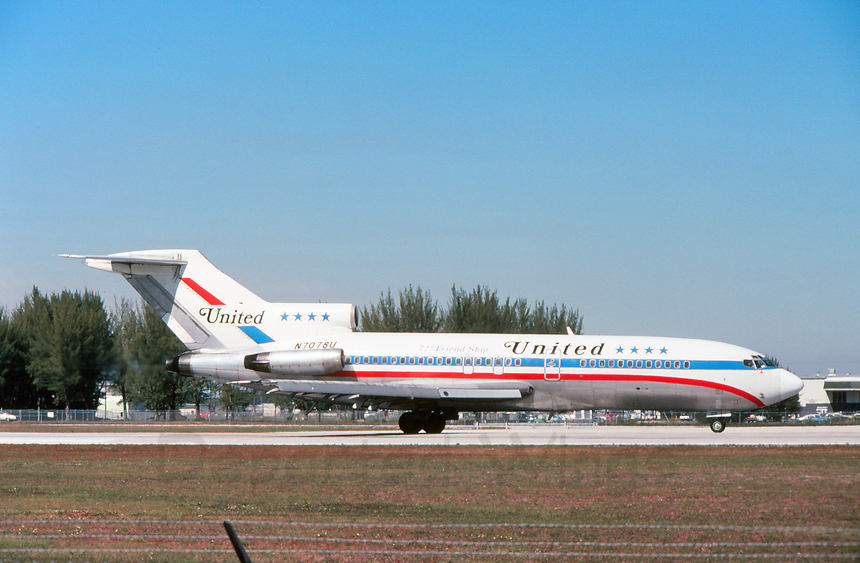
| February
1978 United Air Lines continued to use the Boeing 727 on a majority of services from Miami into the late 1970s. The airline had daily flights from Miami to Buffalo, Cleveland, Pittsburgh, Rochester, and West Palm Beach using both the Boring 727-100 and -200 series. Seen holding in position for takeoff on Runway 9 Right and still wearing the "Friendship" color scheme is N7078U, a Boeing 727-22, delivered new to the airline on July 30, 1967. |
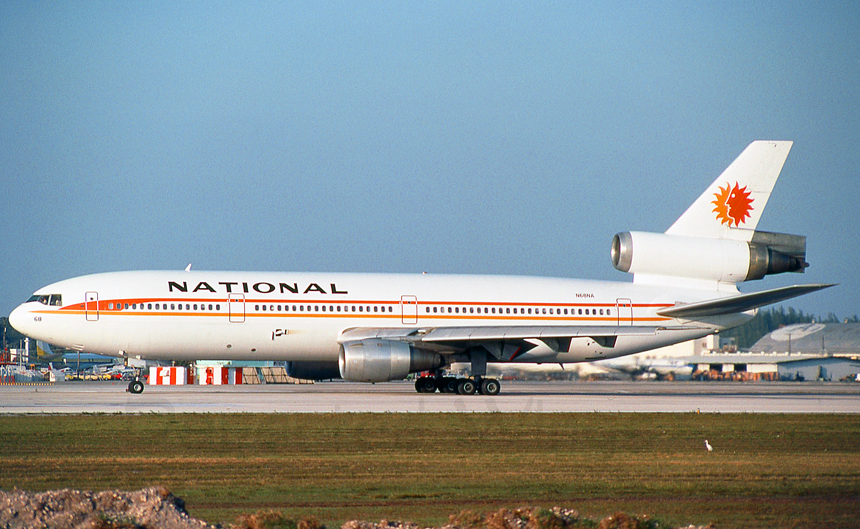
| March
1978 With a headquarters of Miami, Florida, National Airlines by 1978, was serving thirteen destinations from Miami with no less then forty daily departures. The "heavy" Douglas DC-10 was used on flights to the West Coast (Los Angeles and San Francisco) as well as non-stop services to all three New York City airports (JFK, LaGuardia, and Newark). Seen taxiing toward Runway 9 Left for an early evening departure is N68NA, a Douglas DC-10-10, delivered new to the airline on December 12, 1972. |
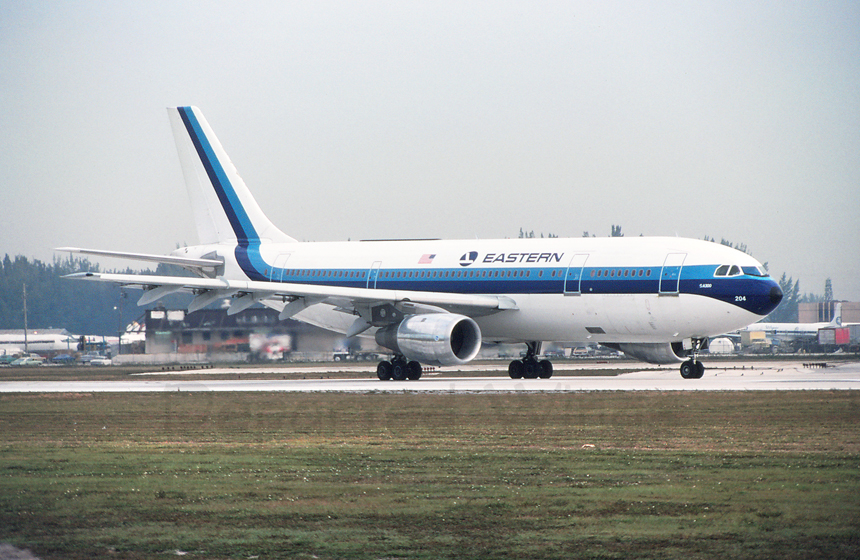
| March
1978 Eastern Air Lines was looking for an aircraft with low seat-per-mile costs and signed a lucrative deal with Airbus to "evaluate" the A-300 during a six-month period. Eastern placed the new wide-body on its "gravy" New York-Miami services in December 1977, and the airline quickly fell in love with the plane. Eastern become the first airline to operate the Airbus A-300 in North America and eventually operated thirty-four of the type, providing the foundation to many of the airlines trunk routes, especially along the East Coast. Seen rolling for takeoff on Runway 12 is, N204EA, an Airbus A-300B4-2C, delivered new to Eastern Air Lines on August 24, 1977. |
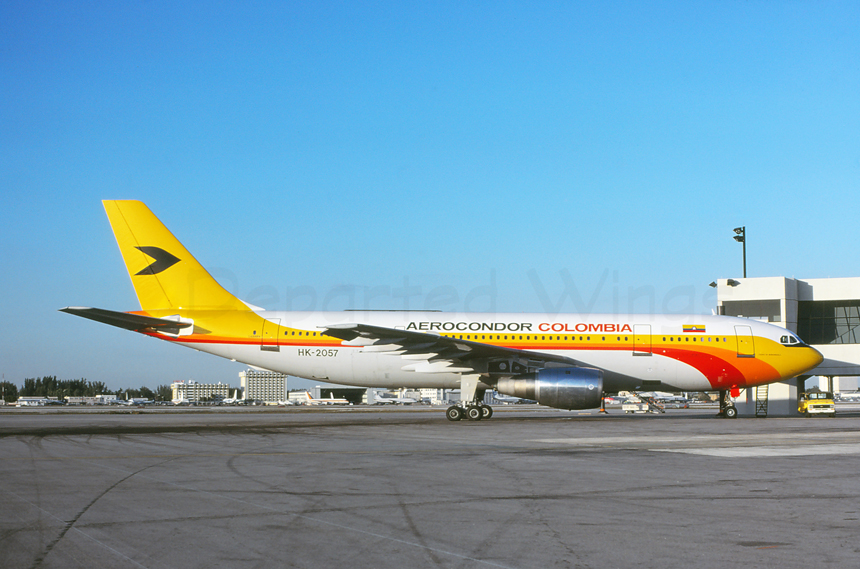
| March
1978 Aerocondor Columbia realizing the growth potential purchased a new Airbus A-300 for services between Miami and Barranquilla and Bogota. Seen parked at the terminal on a bright spring morning is HK-2037 "Ciudad de Barranquilla," an Airbus A-300B4-2C. |
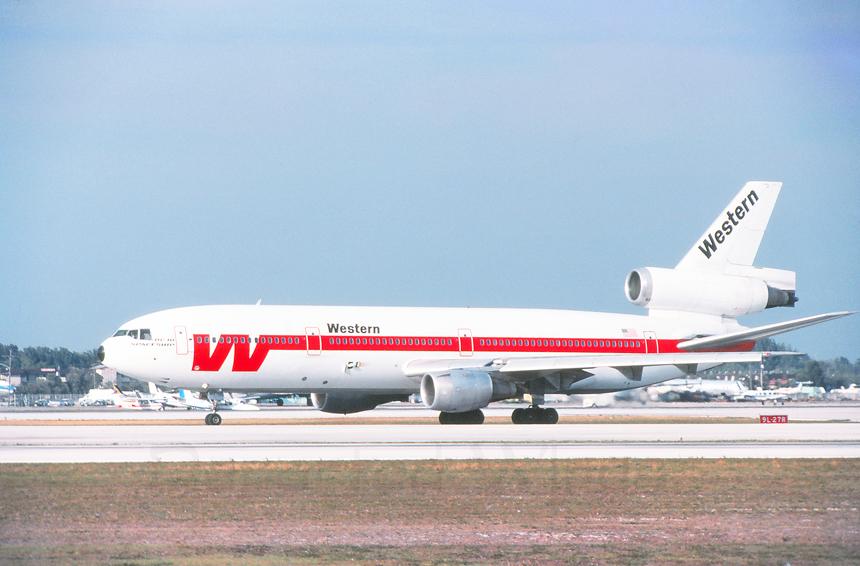
| March
1978 Western Airlines received Civil Aeronautics Board (CAB) approval to start service to Miami on August 1, 1976 with two daily non-stop flights to Los Angeles using the "Spaceship" Douglas DC-10. As the furthest destination east for the airline, the Miami service introduced Florida to the Western system and connecting flights along the West Coast and Hawaii. Seen taxiing out to Runway 9 Left for a afternoon departure is N903WA, a Douglas DC-10-10, delivered new to the airline on June 21, 1973. This aircraft was subsequently destroyed in a landing accident at Mexico City-Juarez International Airport on October 31, 1979. |
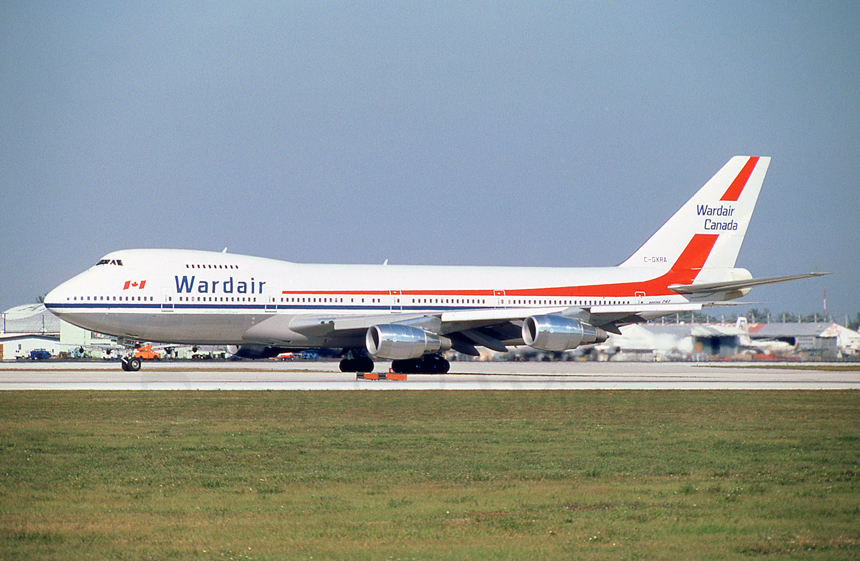
| January
1979 Originally founded by Max Ward in 1946, Wardair provided both scheduled and charter flights within Canada and internationally to Europe and the United States. The airline received its first jet aircraft in 1966, a Boeing 727 for intra-Canada flights. Eventually the Boeing 707 was added for trans-Atlantic services and the airlines first Boeing 747 was delivered in 1973. The Boeing 747 was used on flights to Europe as well as winter services to Miami from Toronto. Seen taxiing toward Runway 9 Left for an afternoon departure is C-GXRA "Herbert Hollick-Kenyon," a Boeing 747-211B, delivered new to the airline on June 9, 1978. |

| February
1979 Although using both the Douglas DC-10 and Douglas DC-8 on flagship services between Miami and Mexico City, Aeromexico introduced the smaller Douglas DC-9 on flights to Mérida when non-stop service to Miami was started in 1978. Seen holding short of Runway 9 Left for an afternoon departure is XA-DEJ "Guadalajara," a Douglas DC-9-32, delivered new to the airlines on February 11, 1974. |
Back to: The Airports